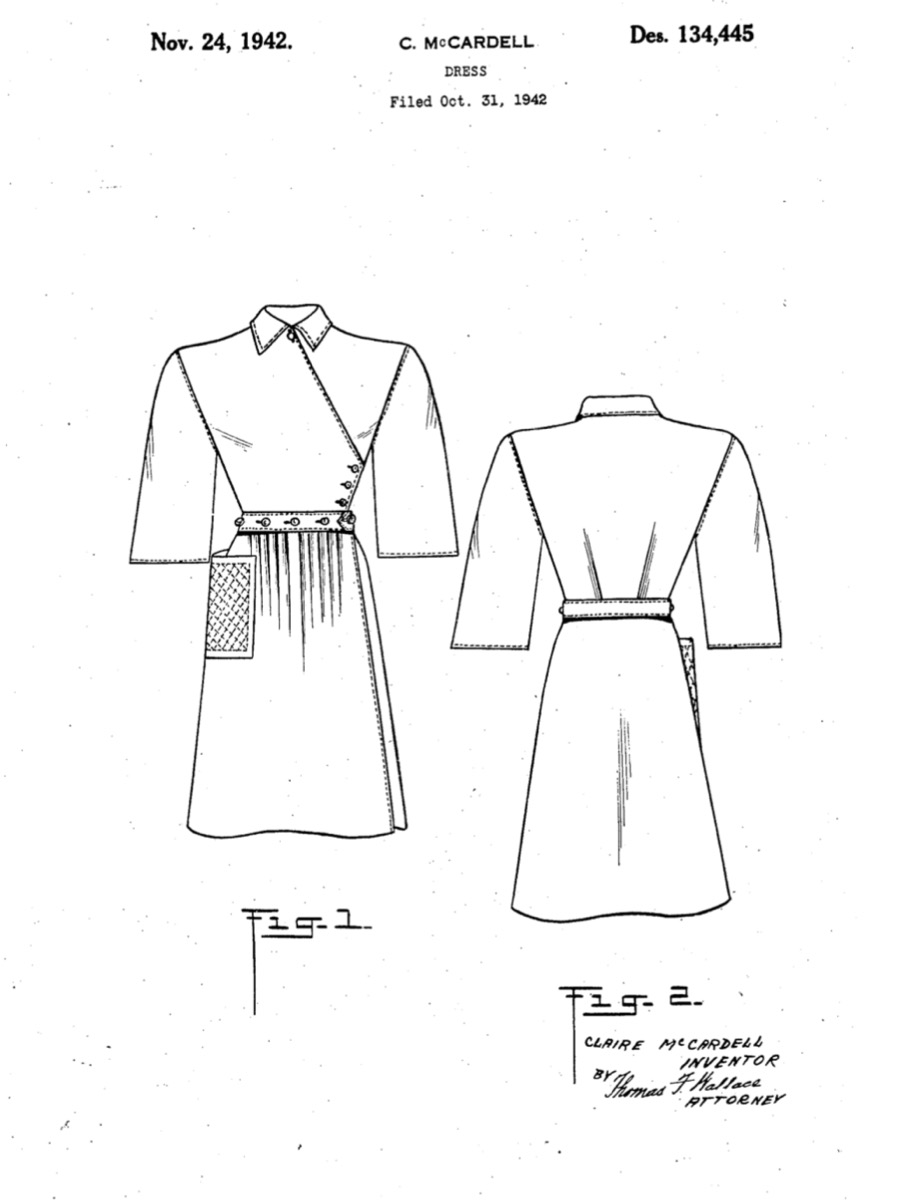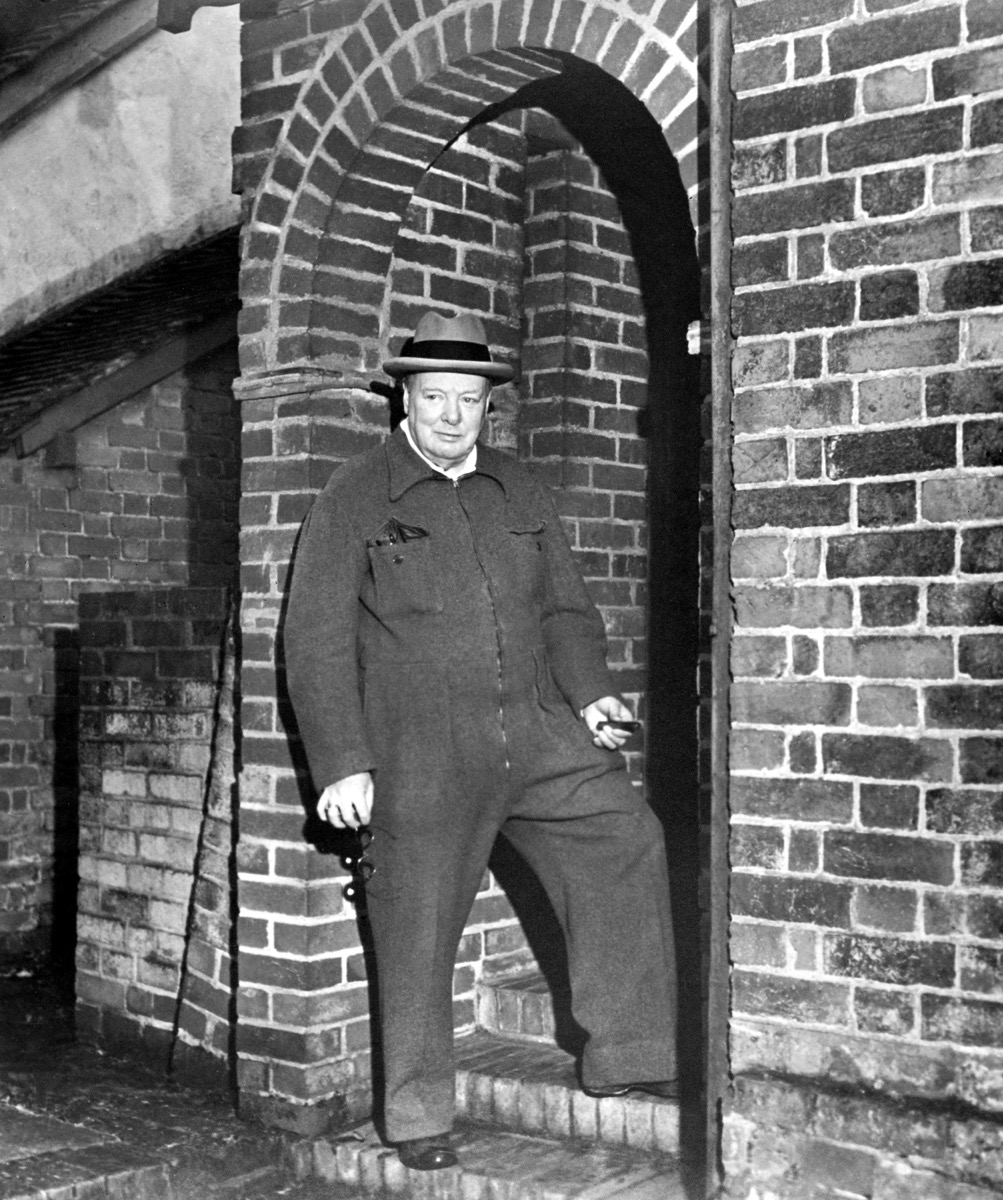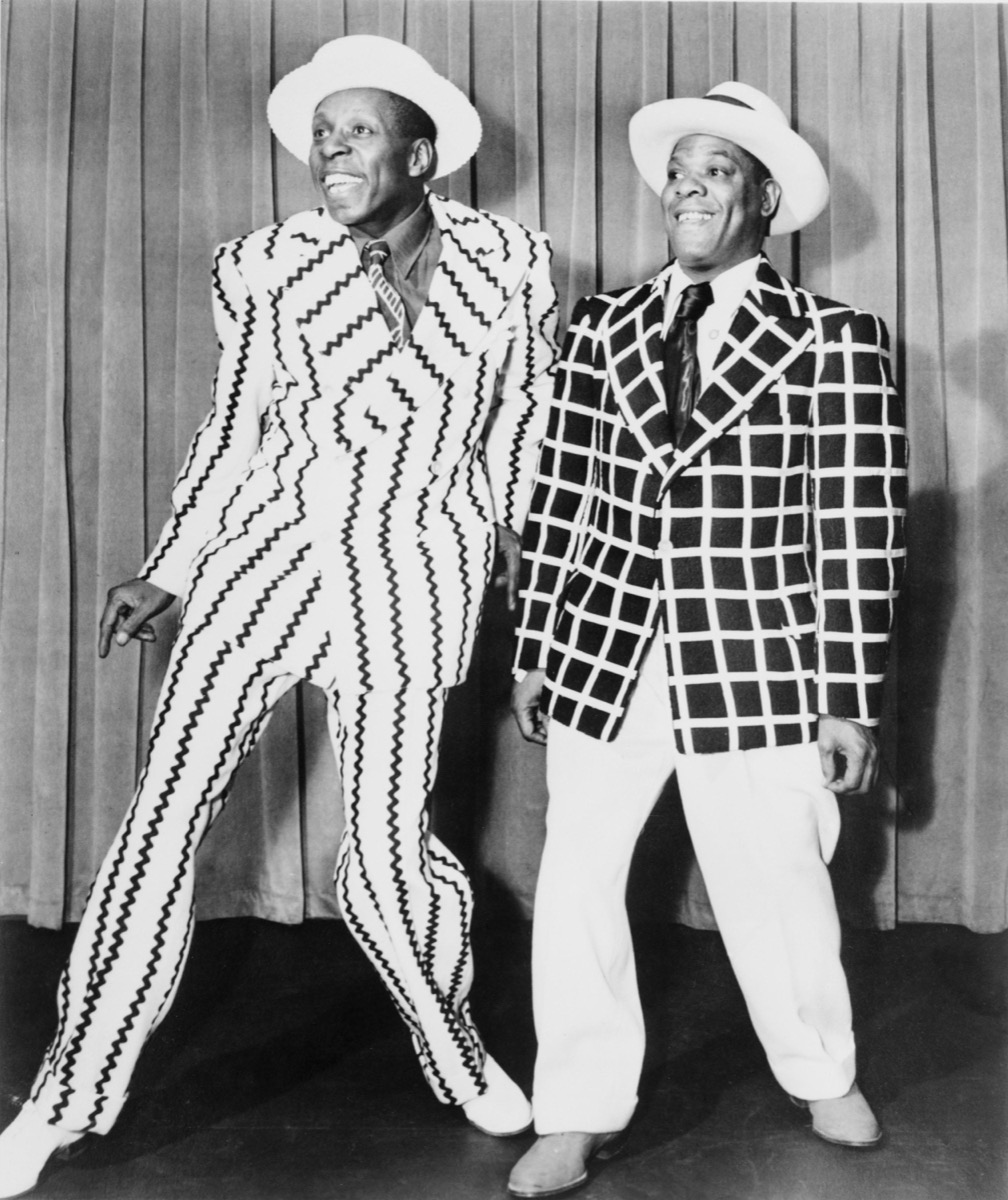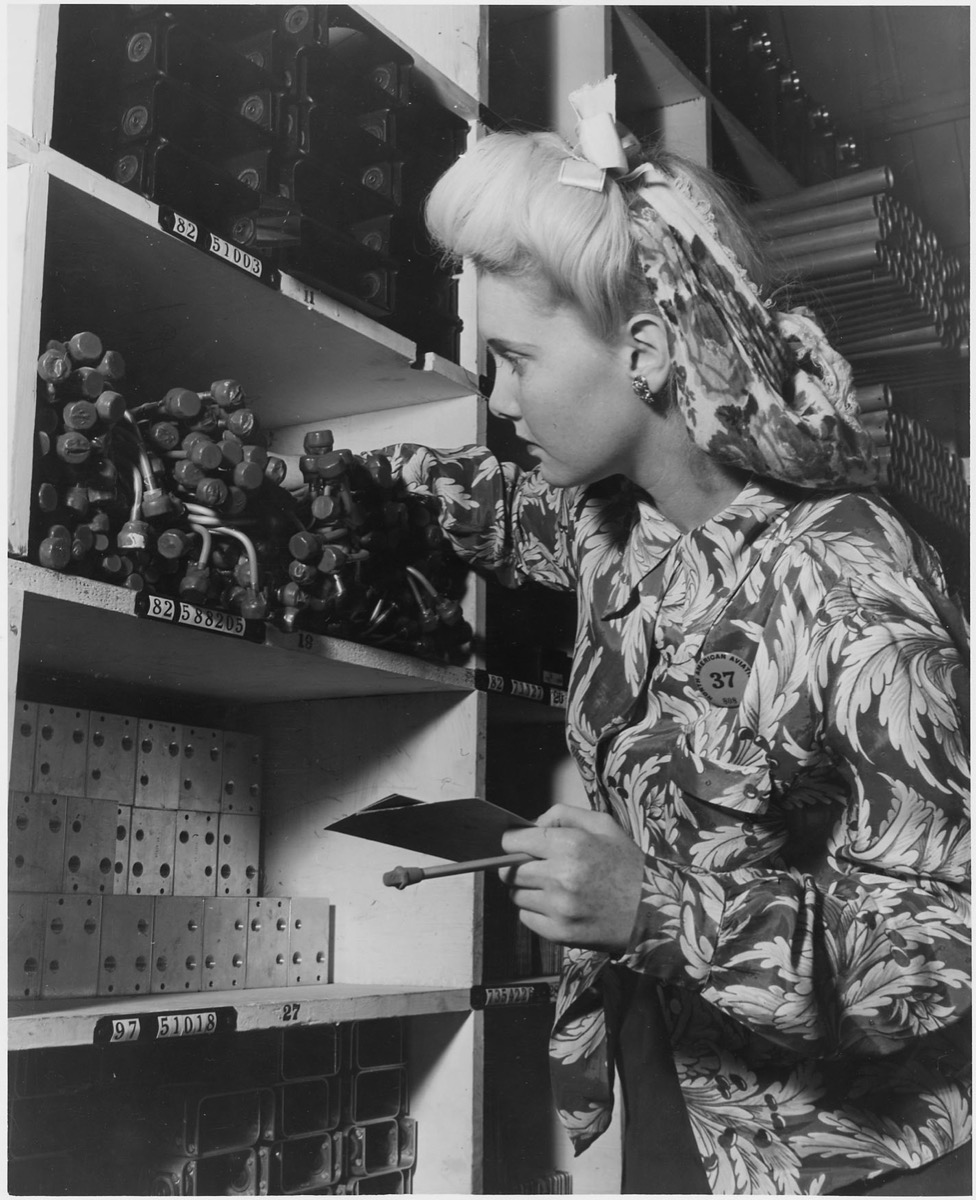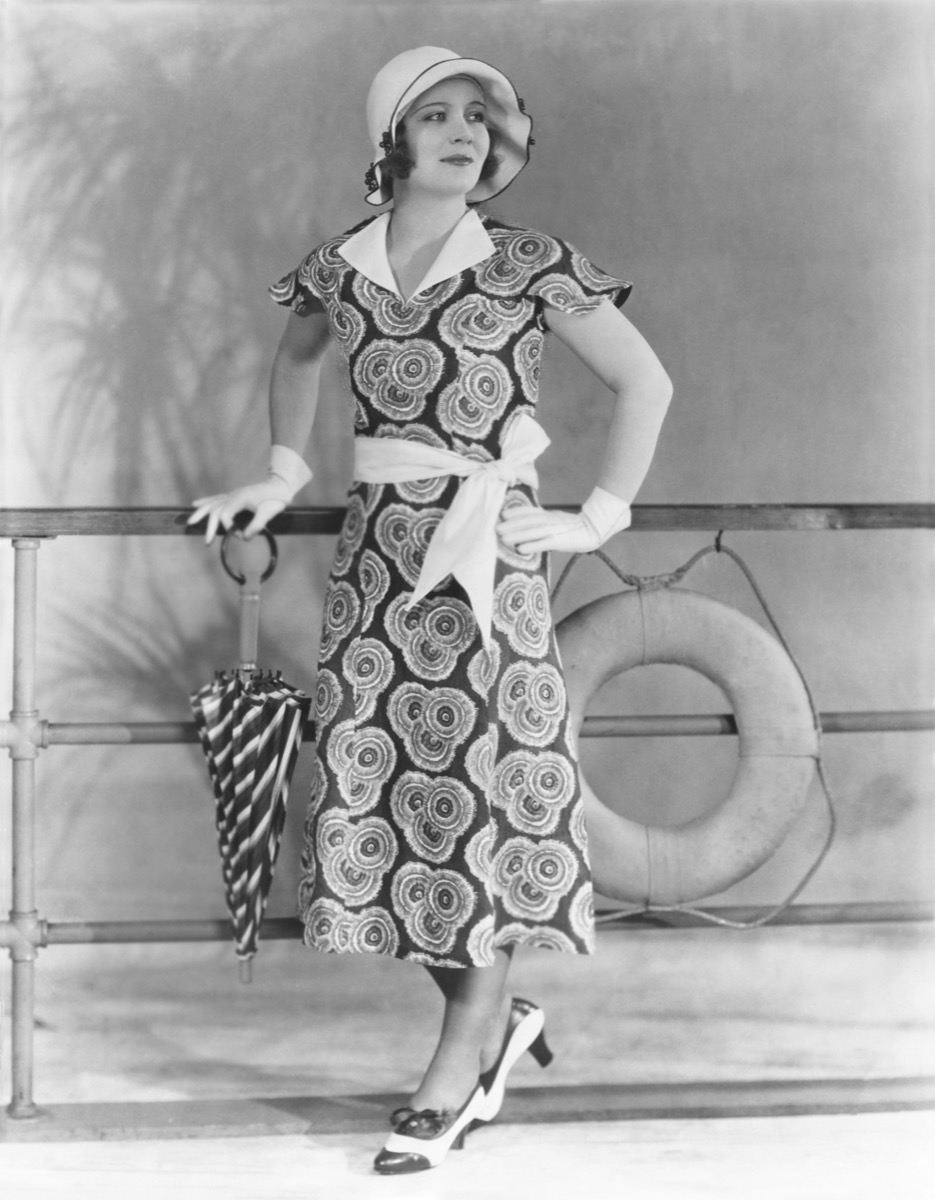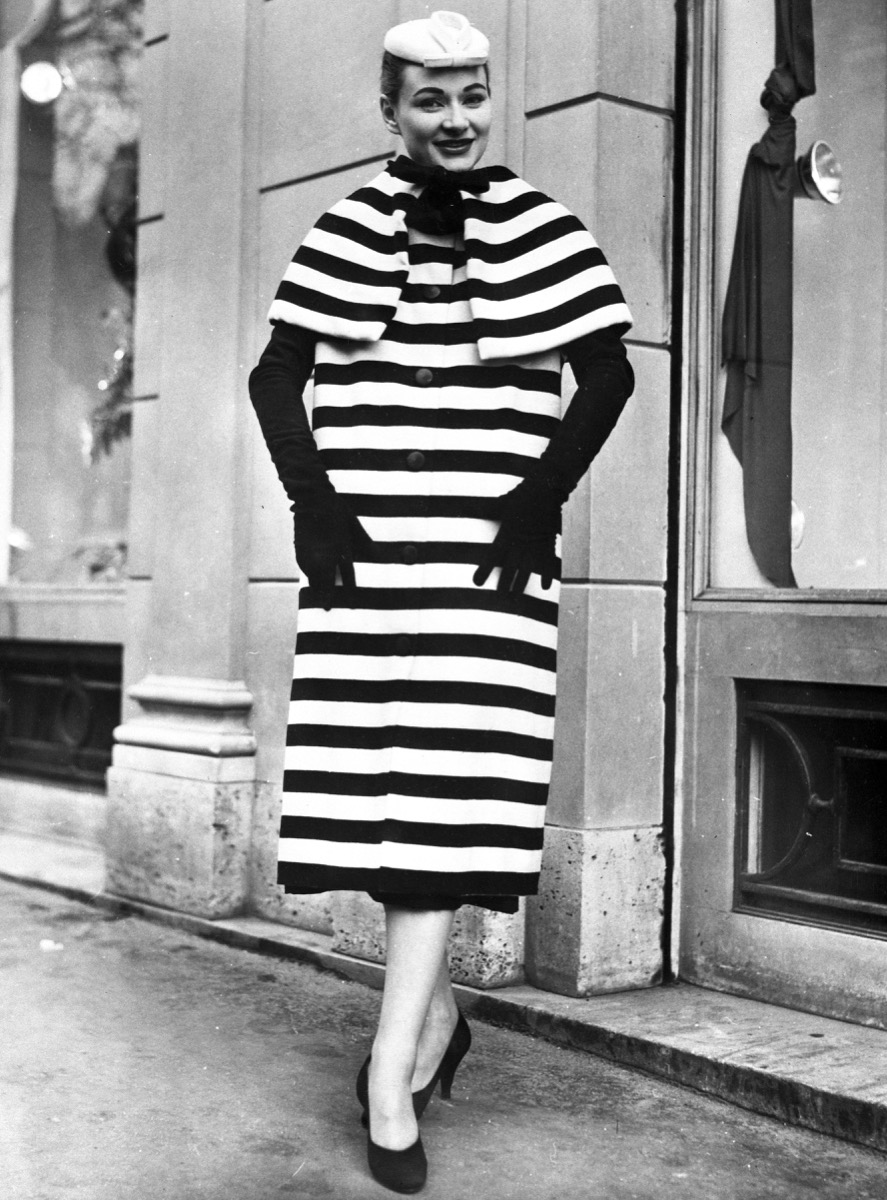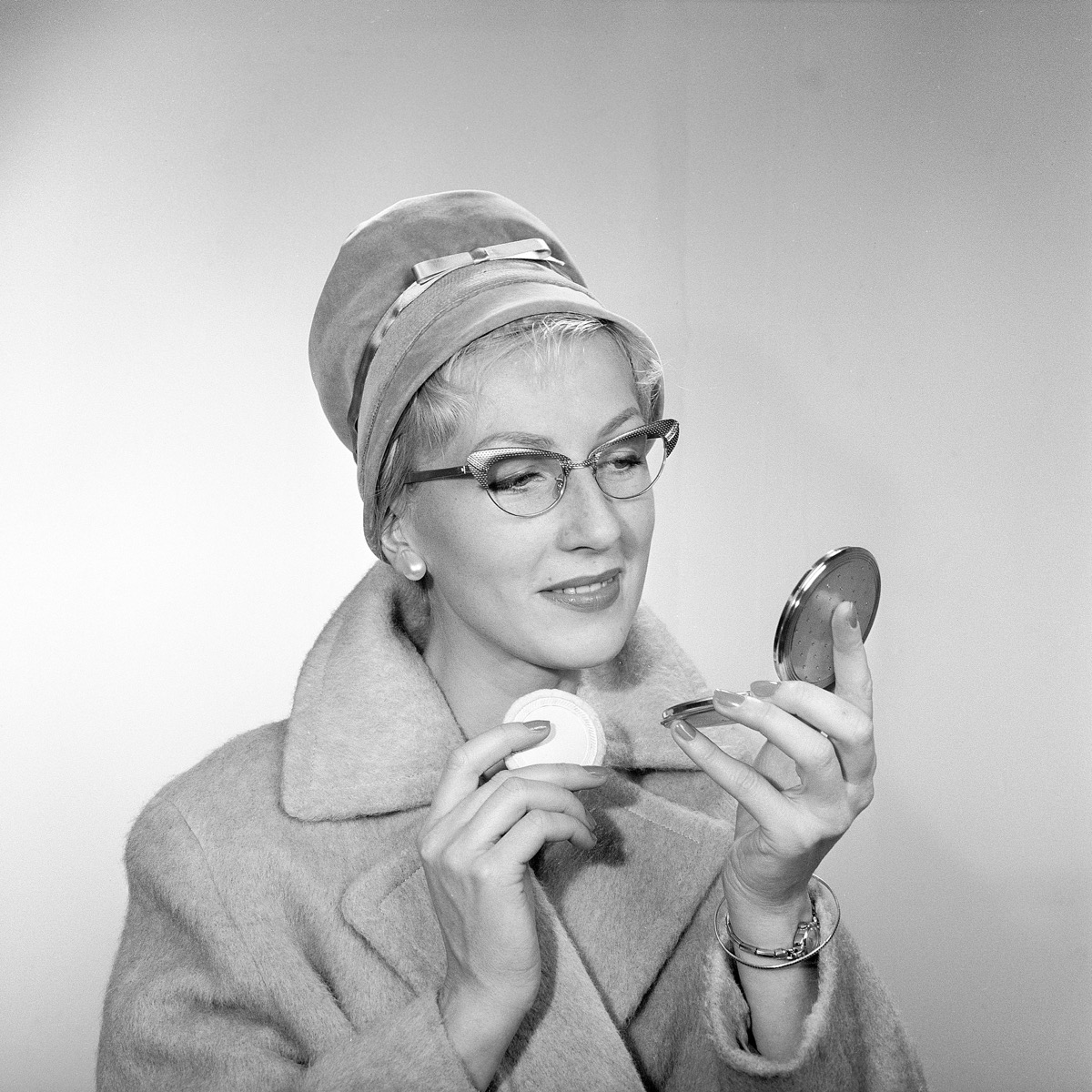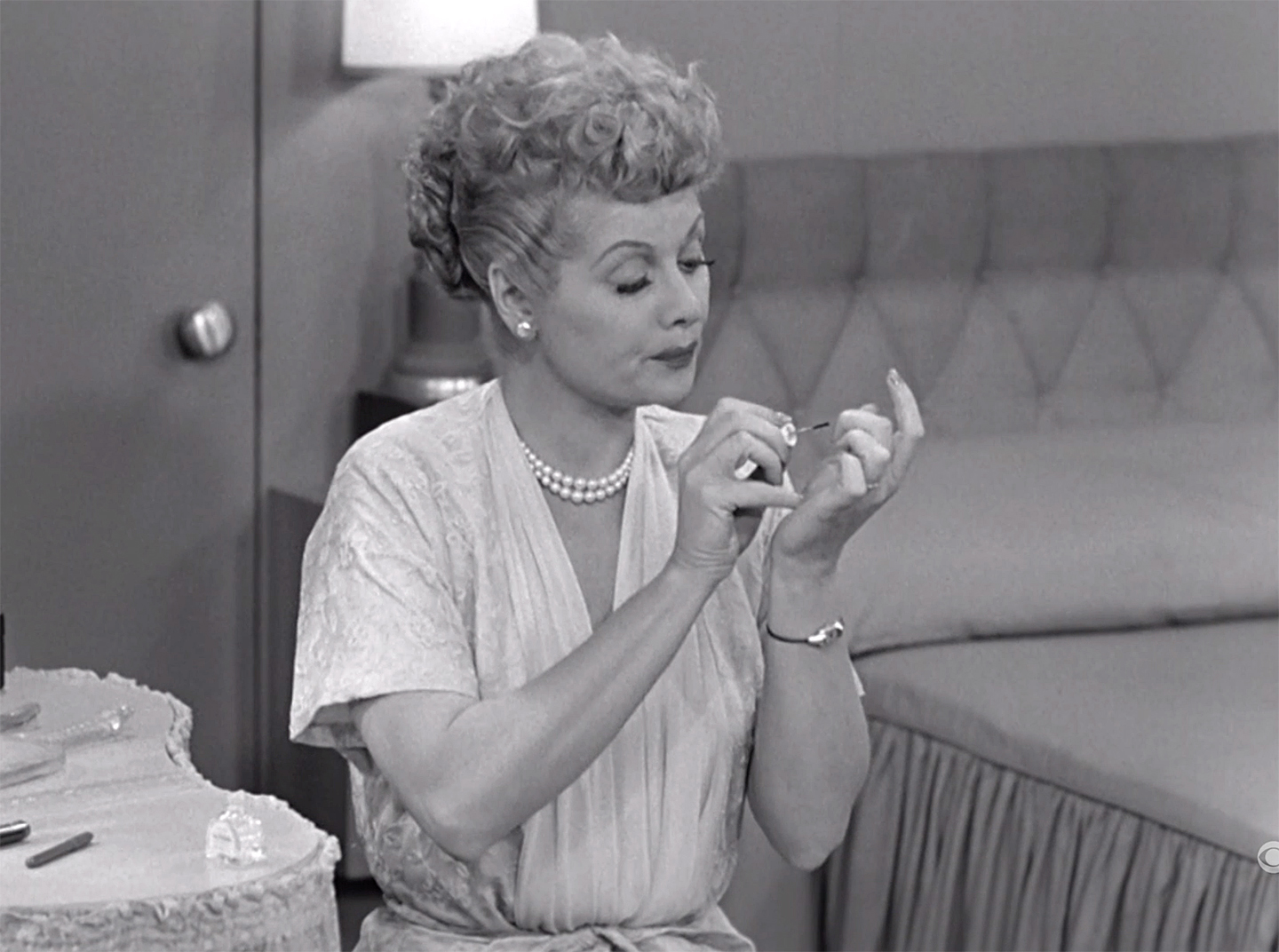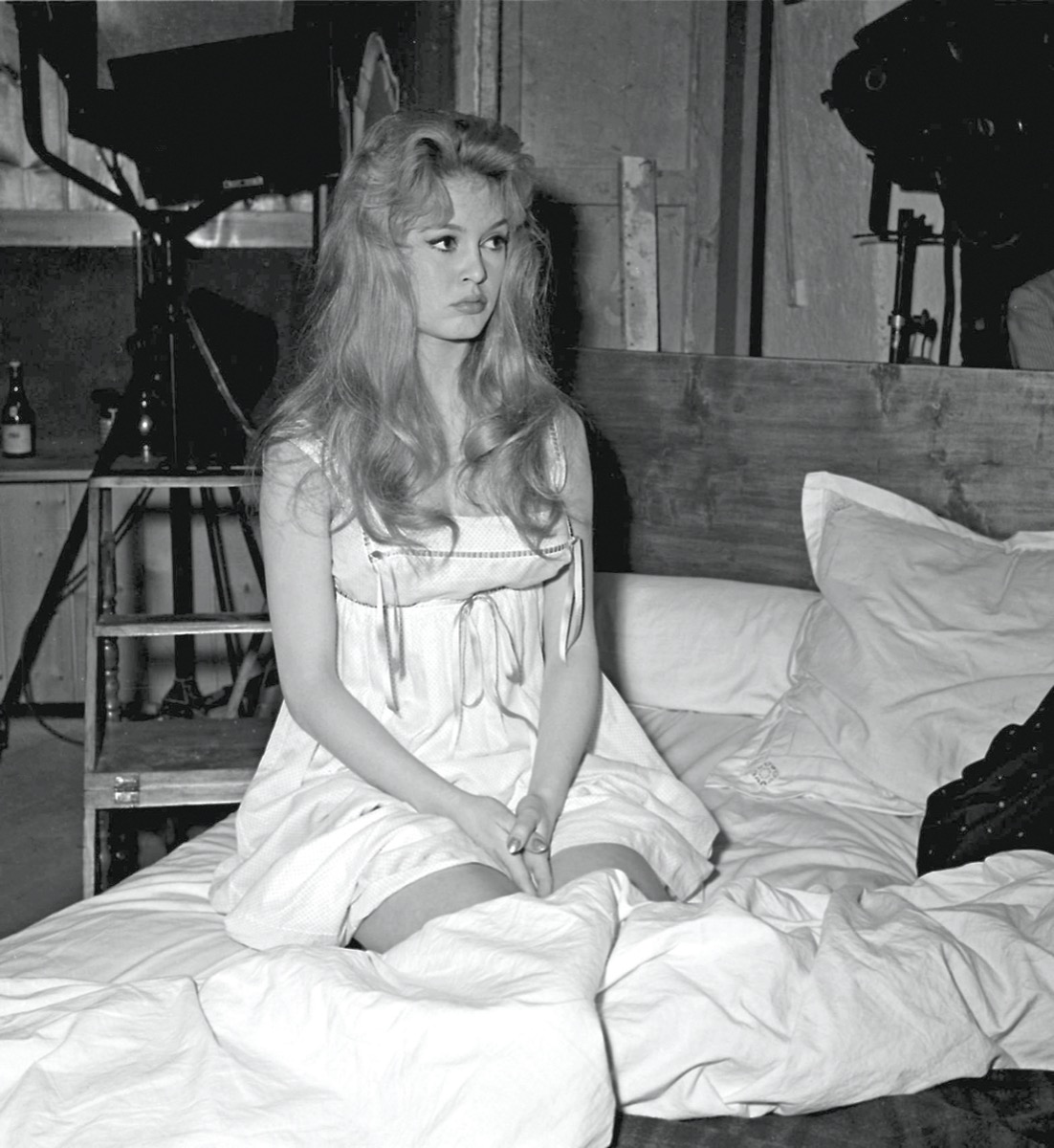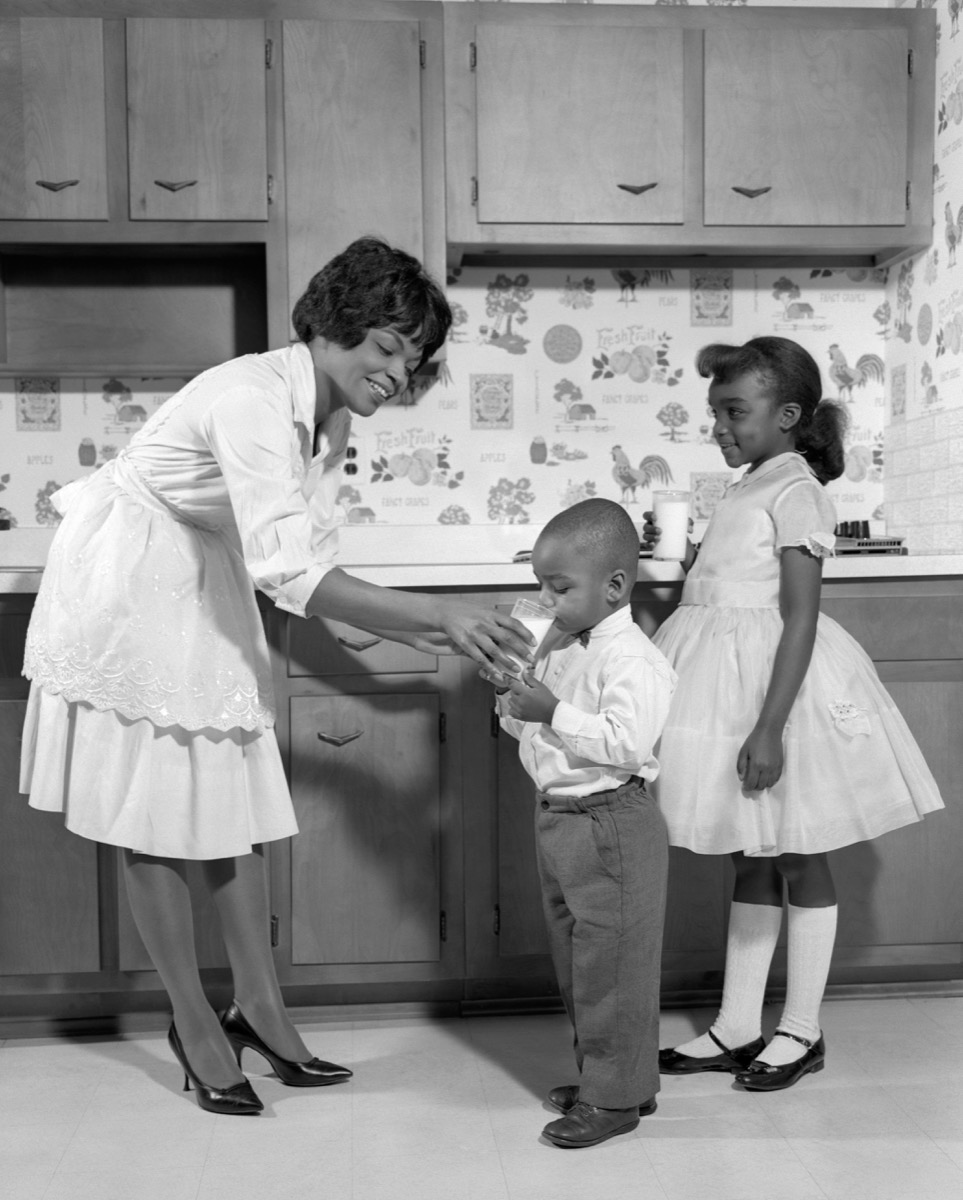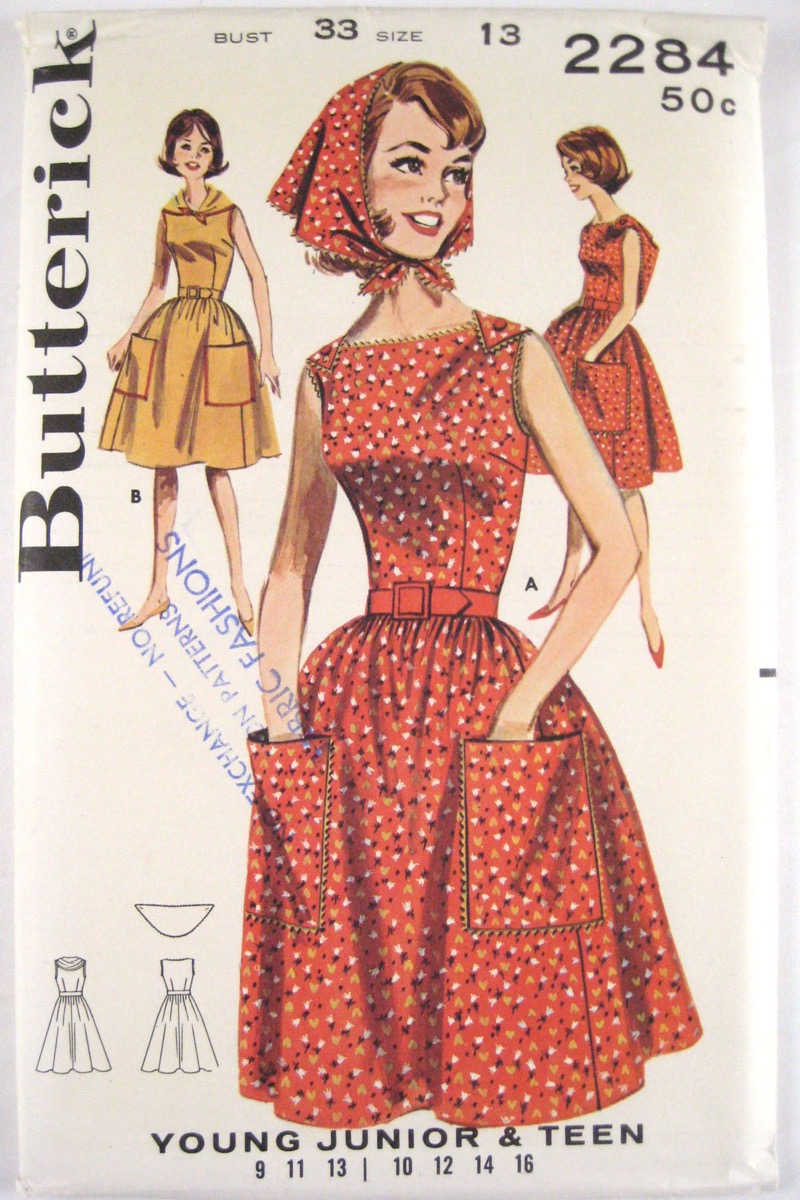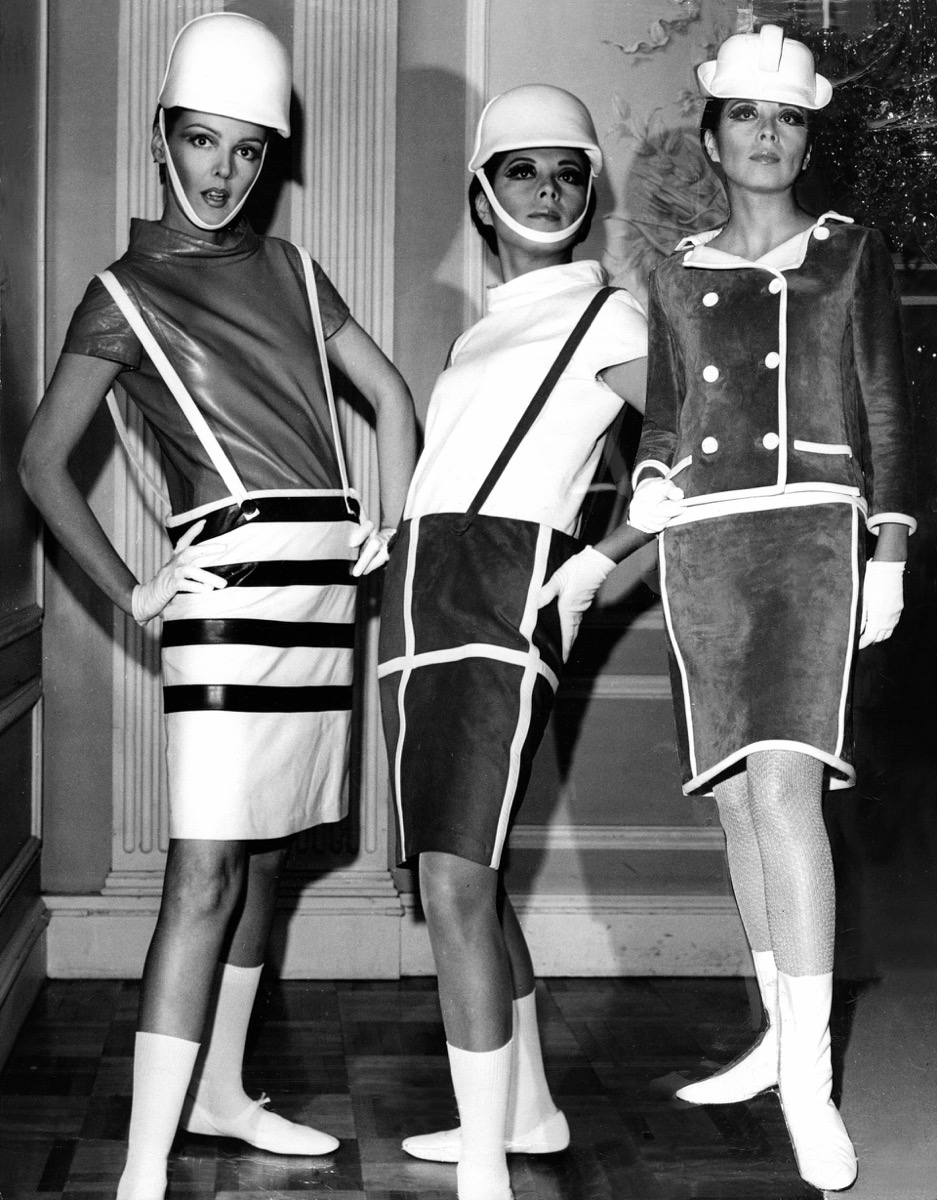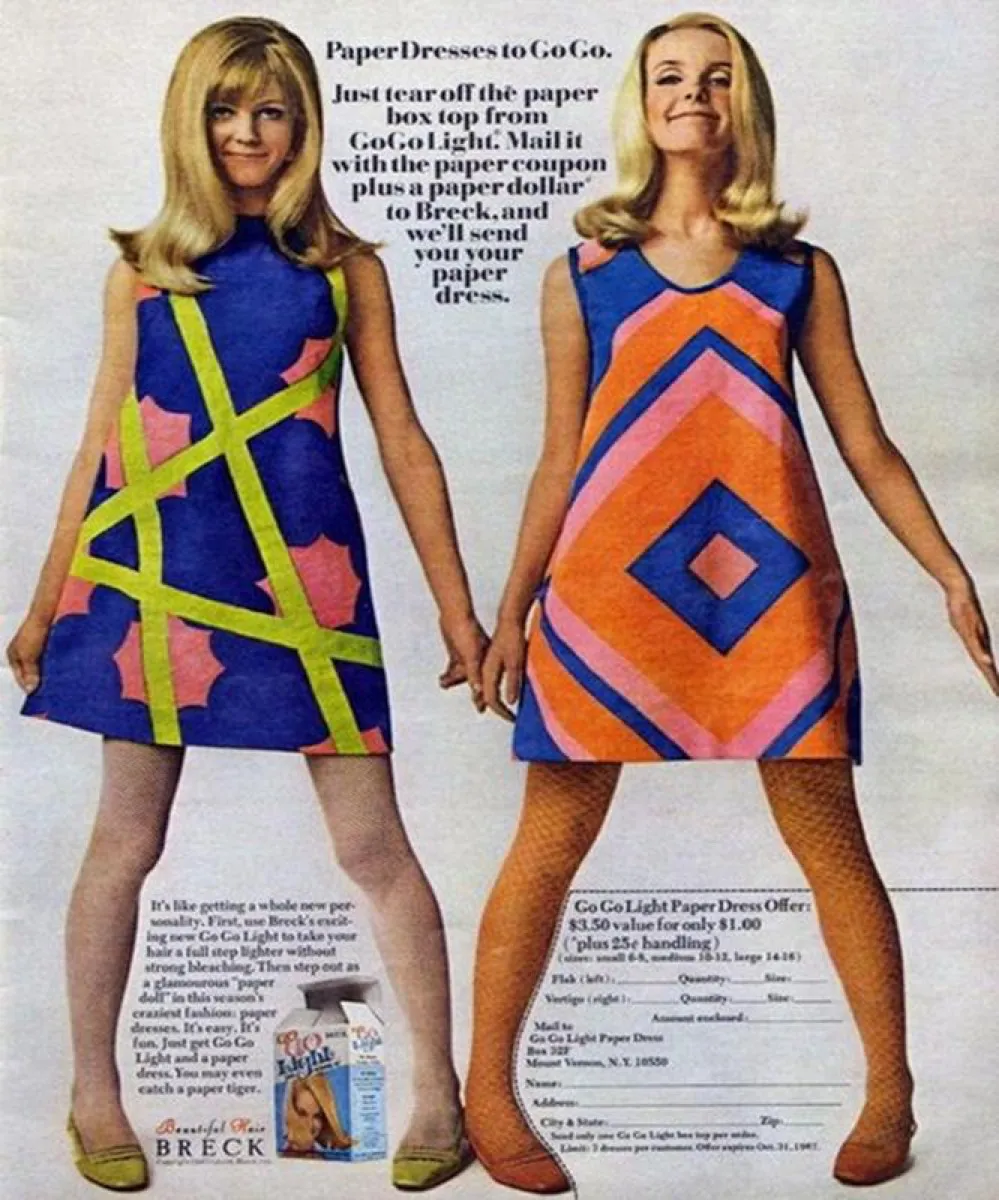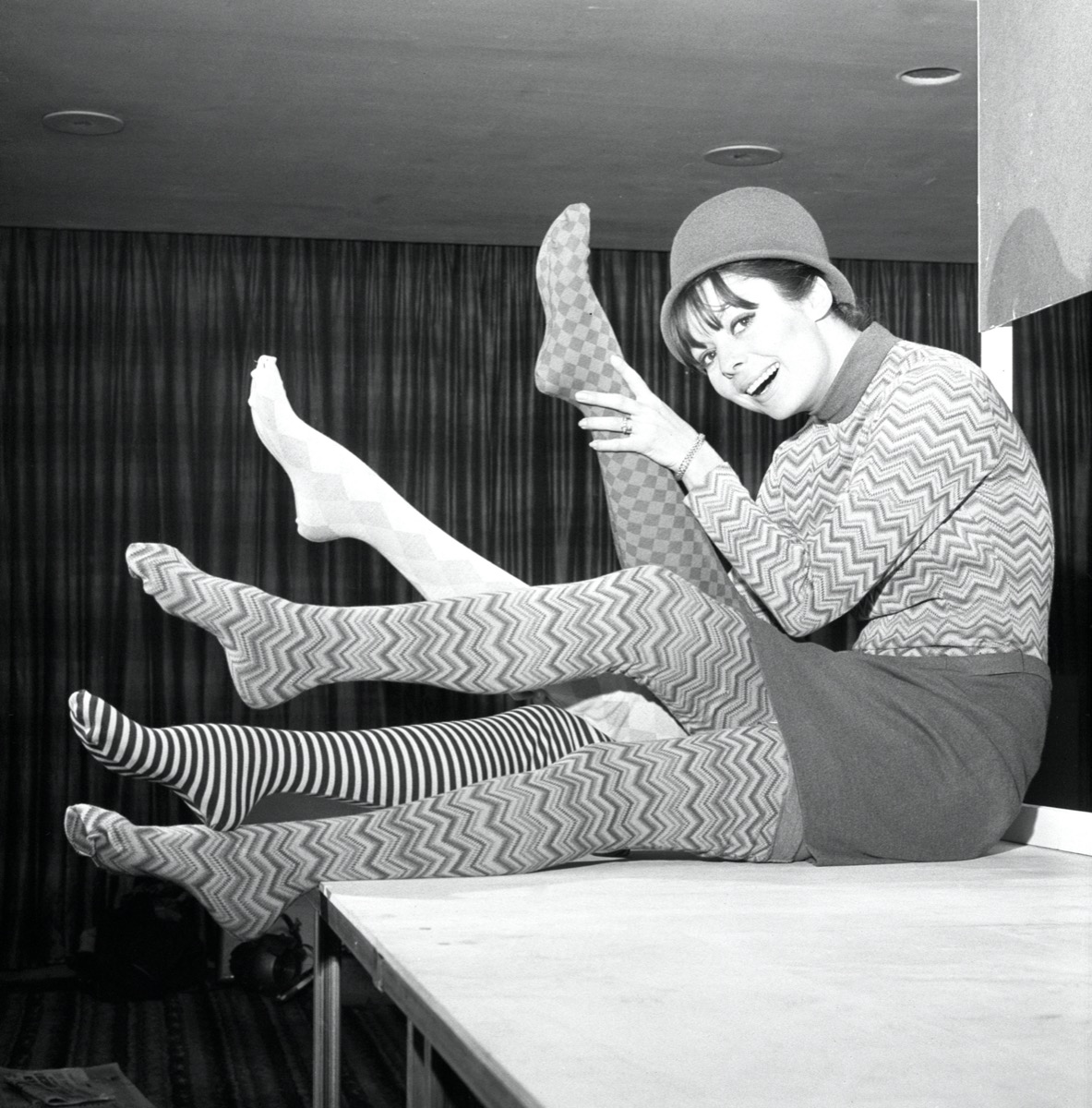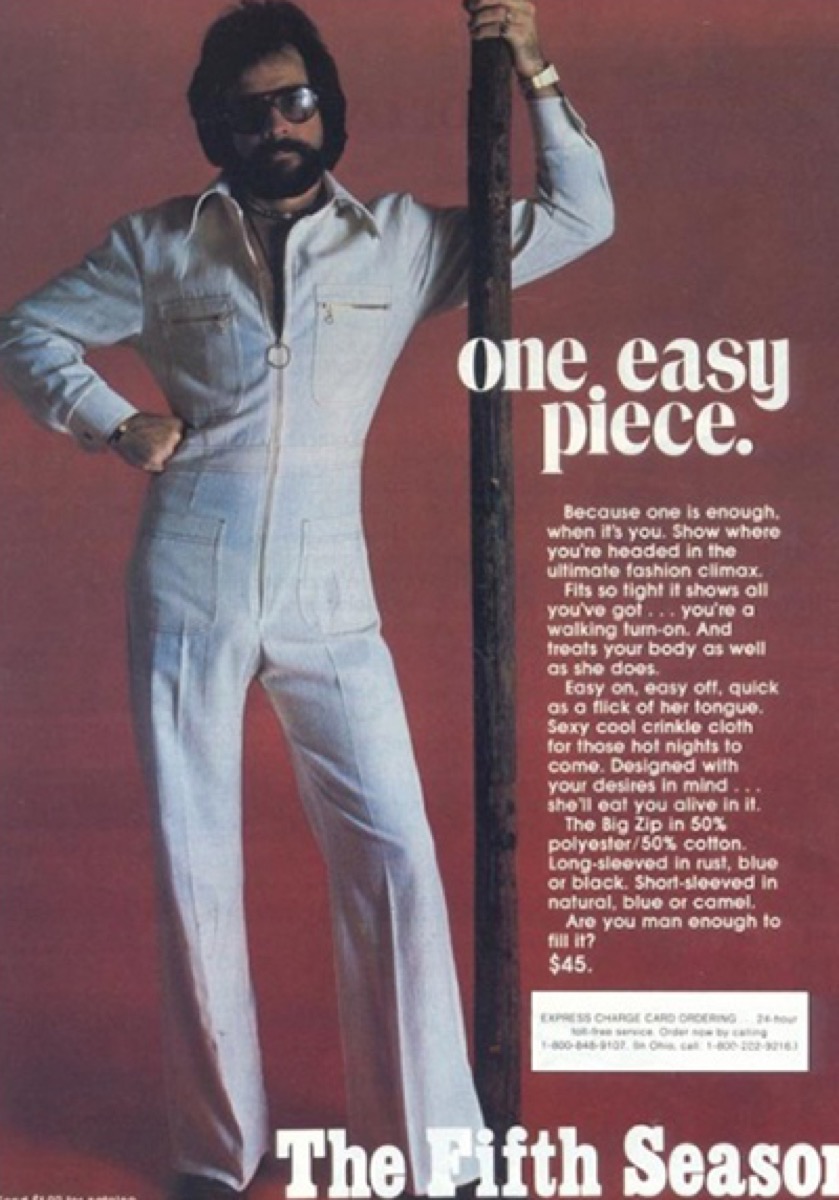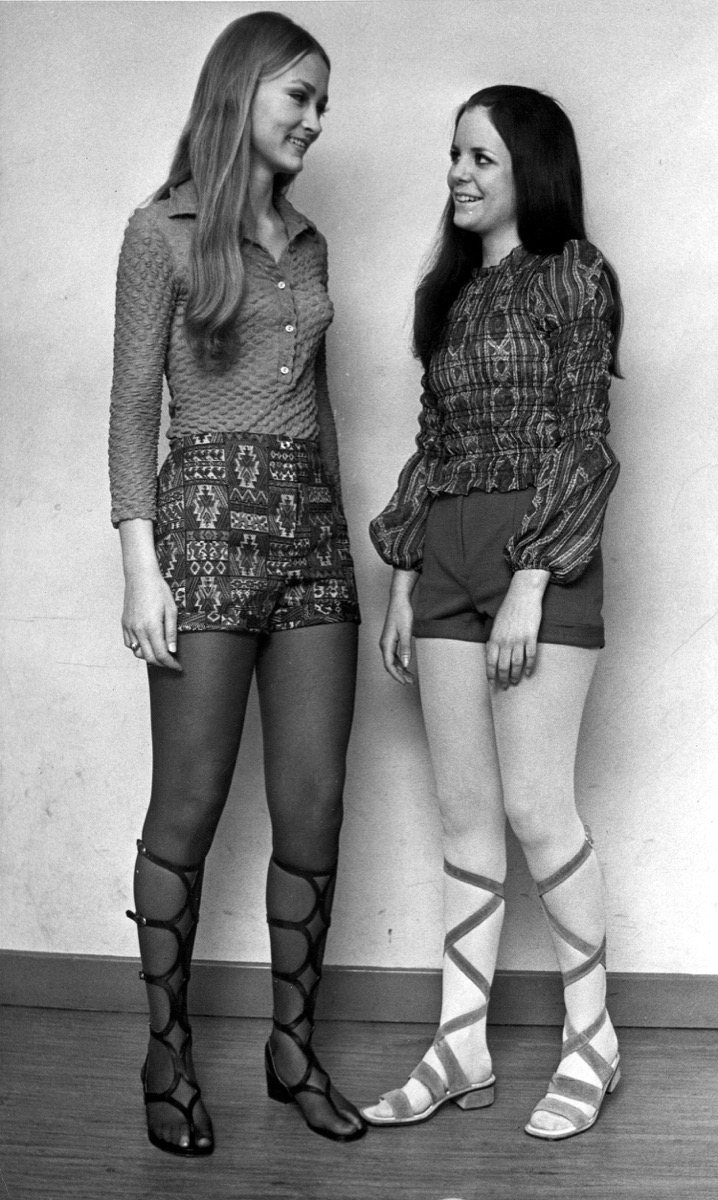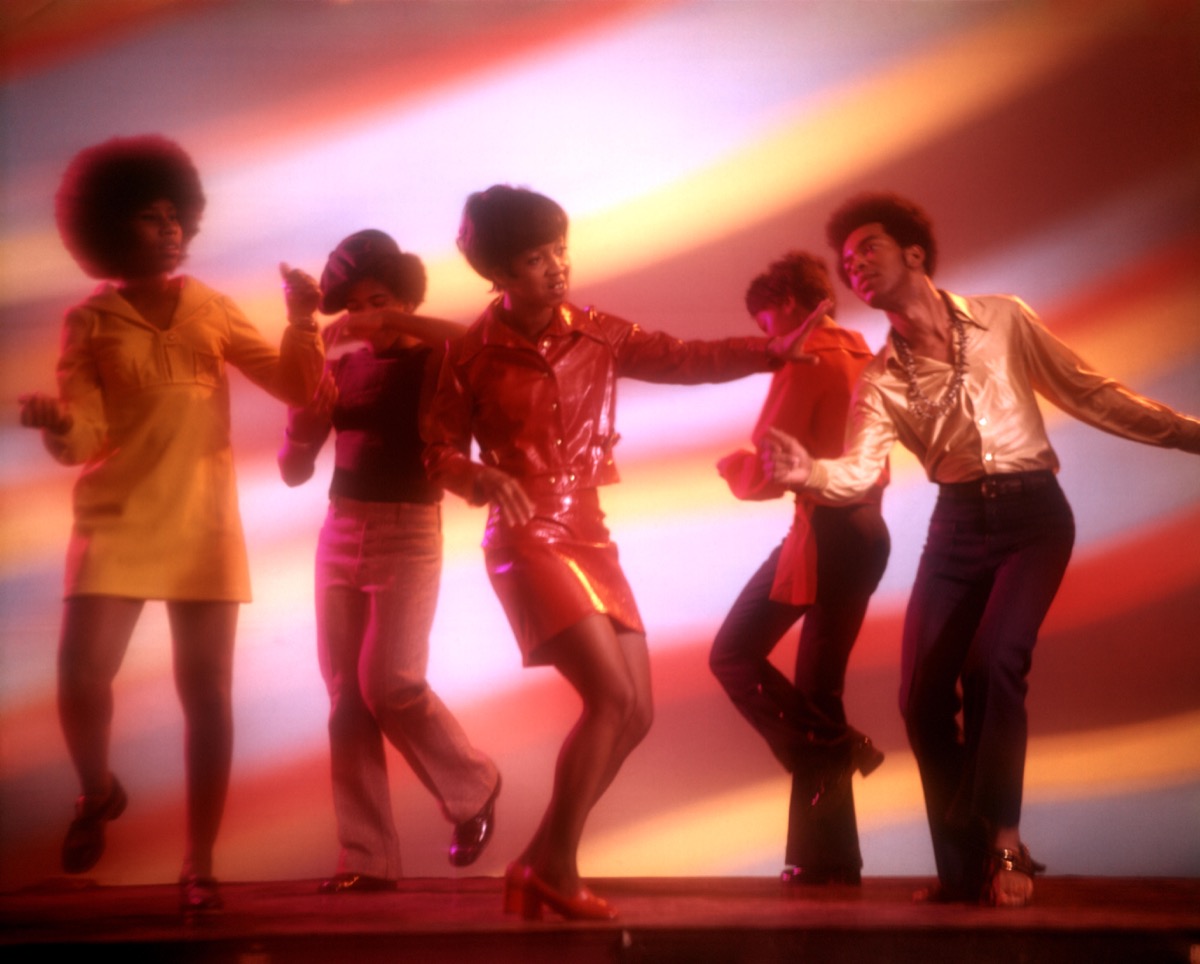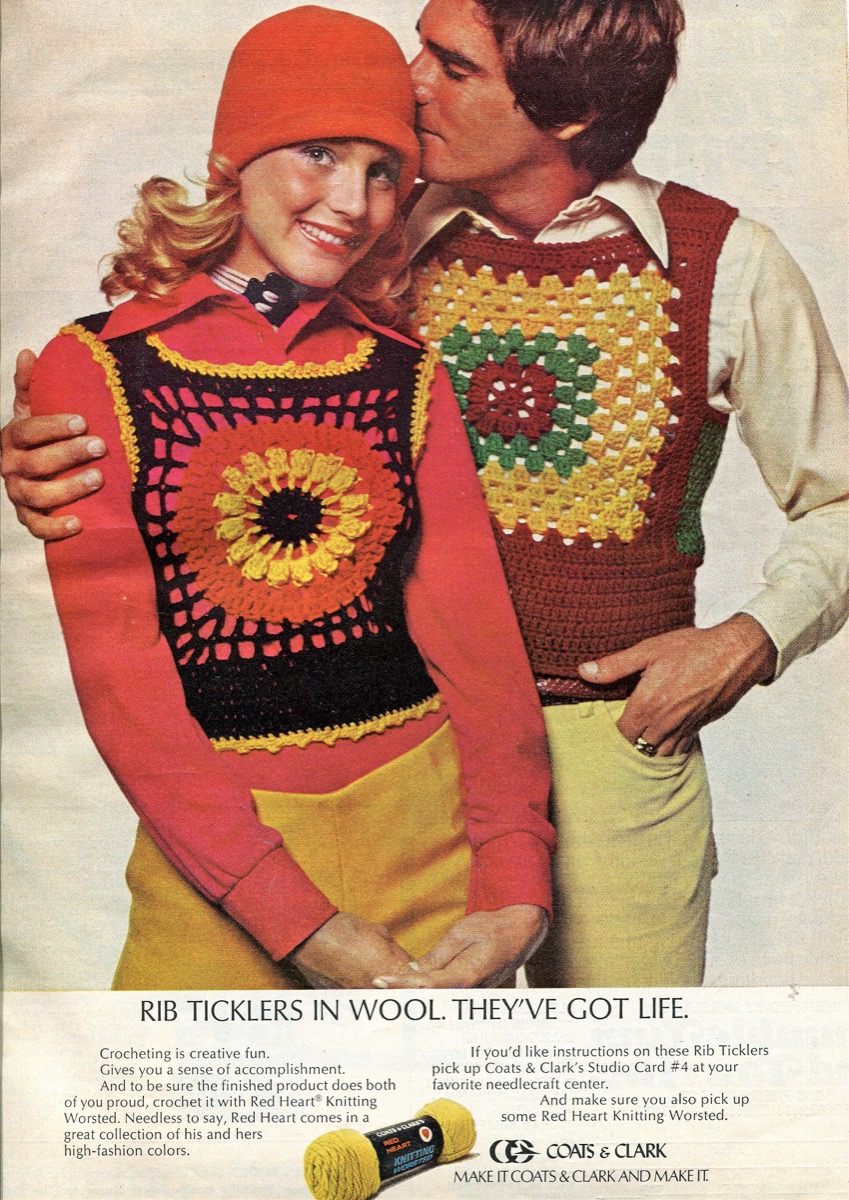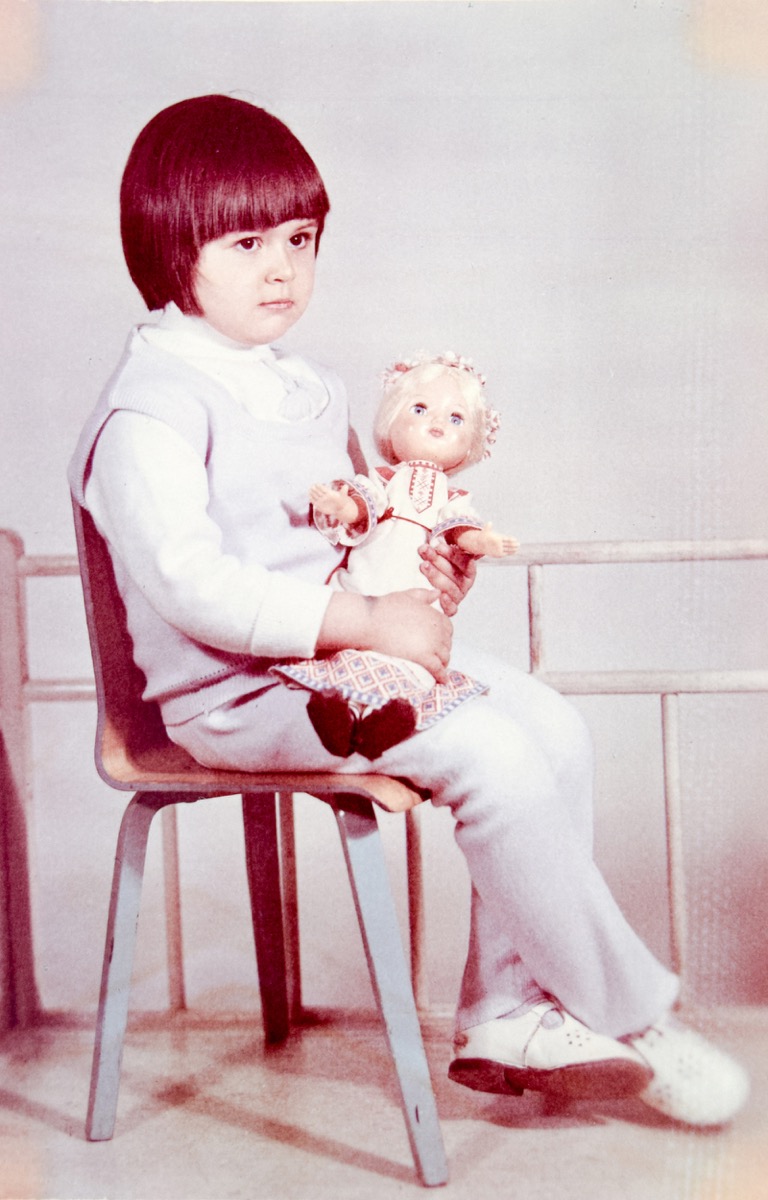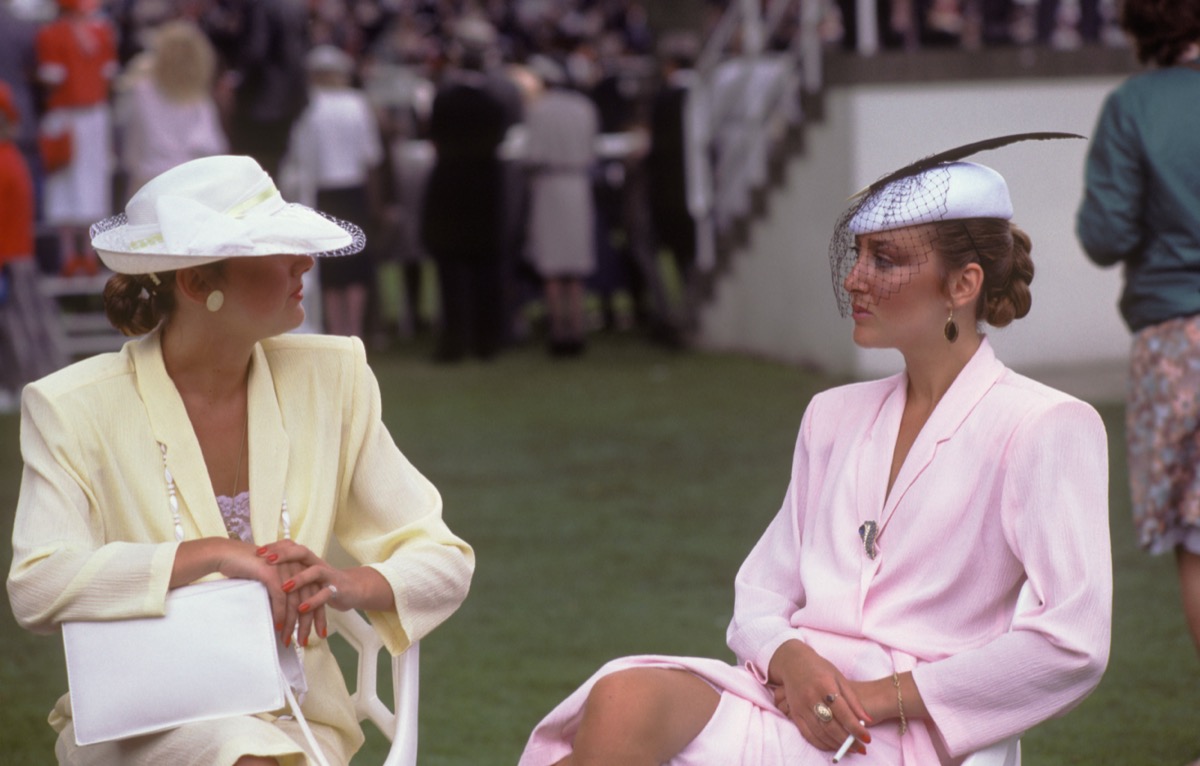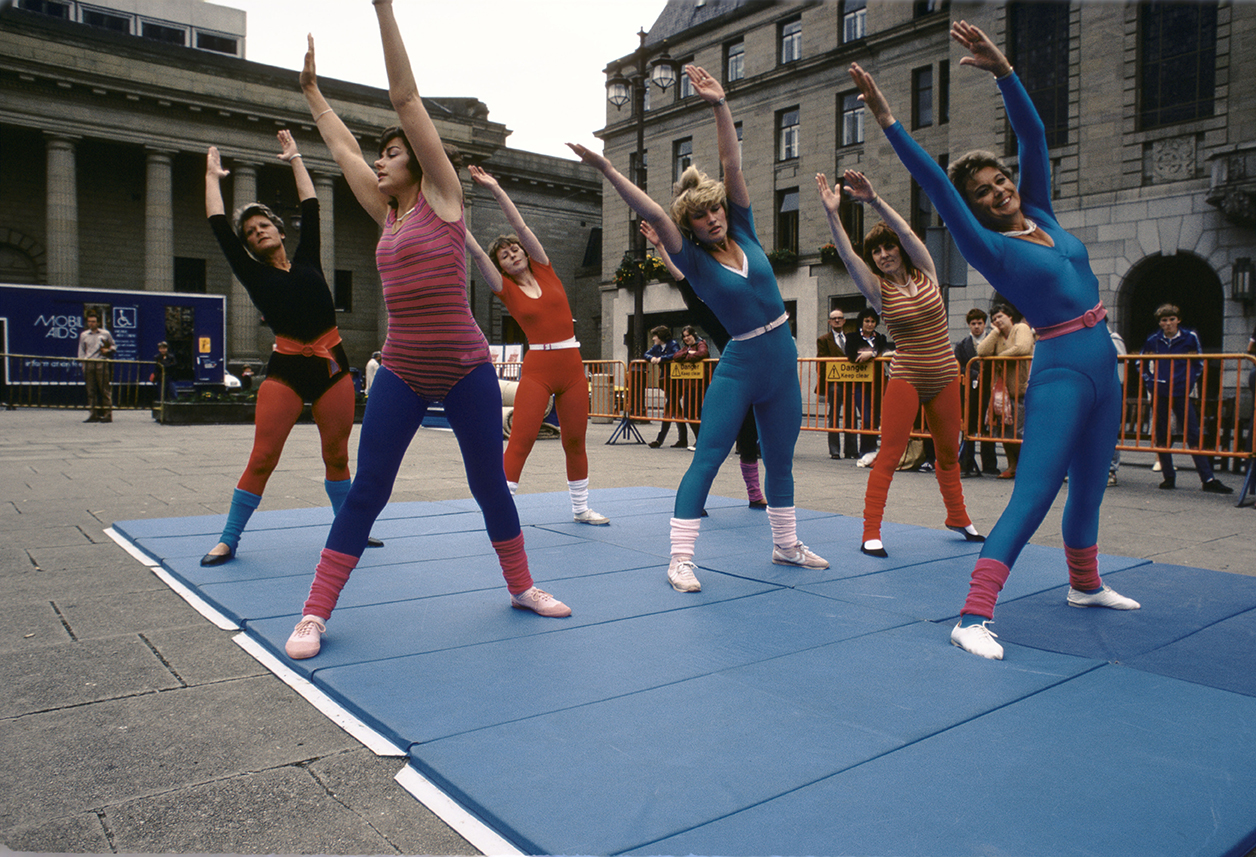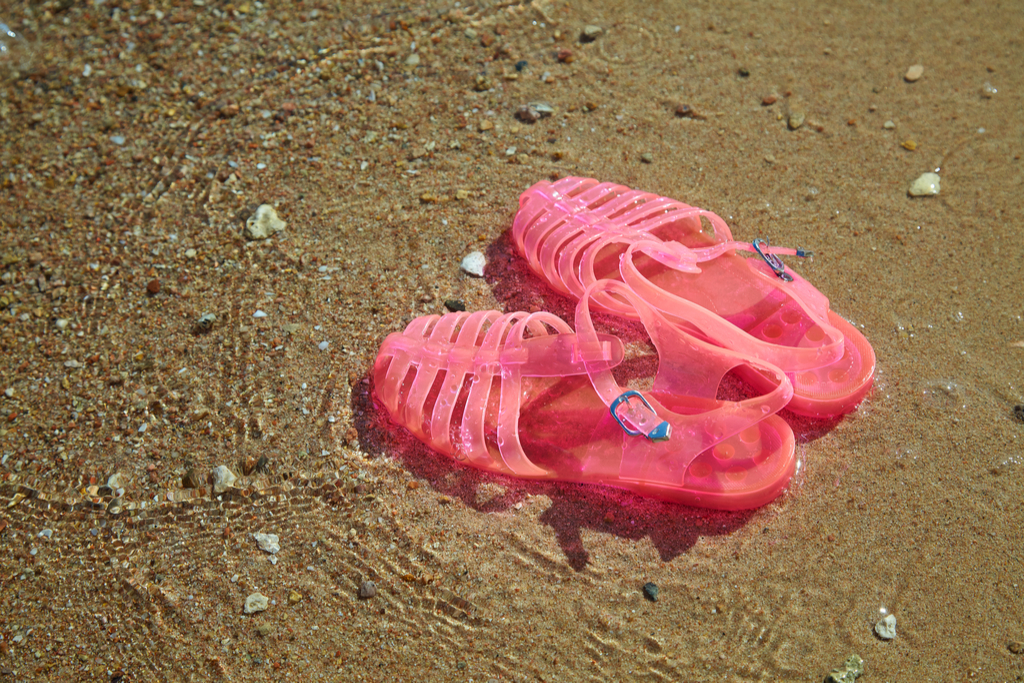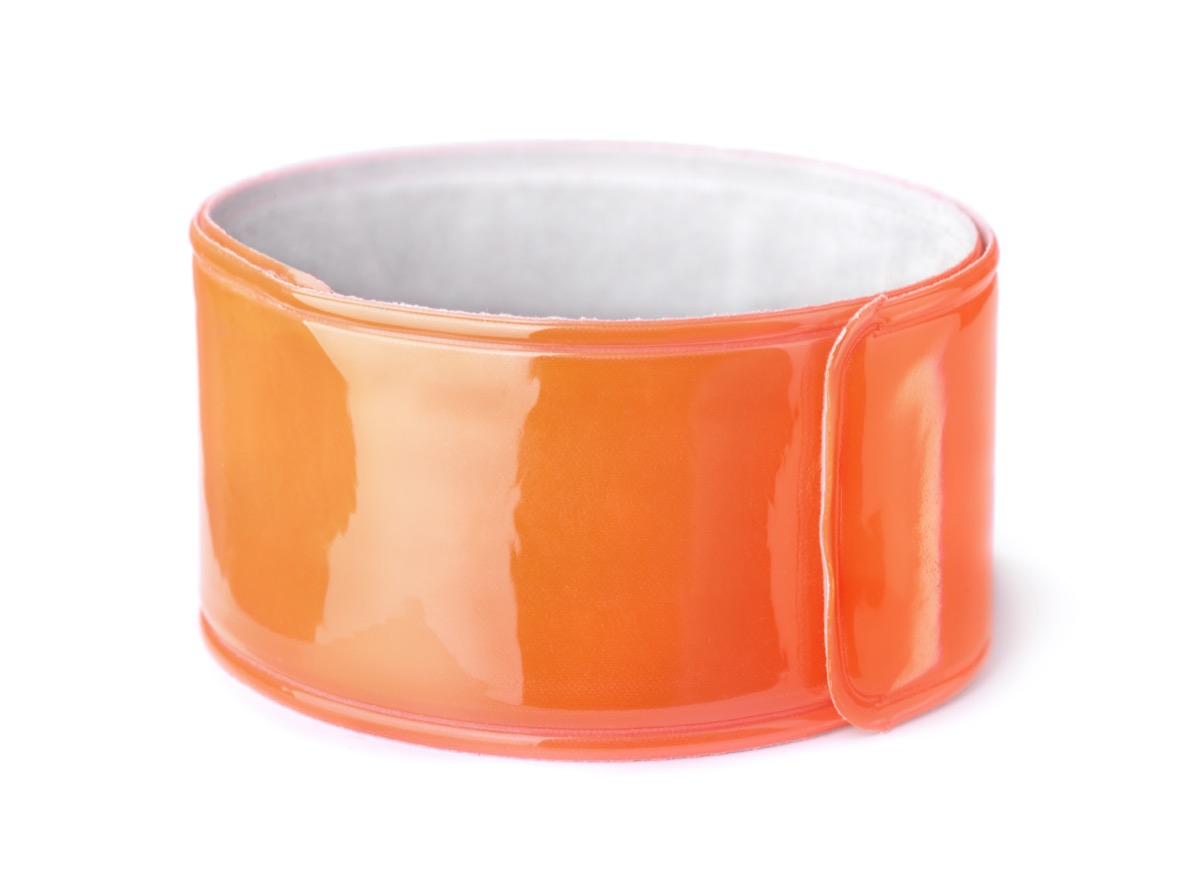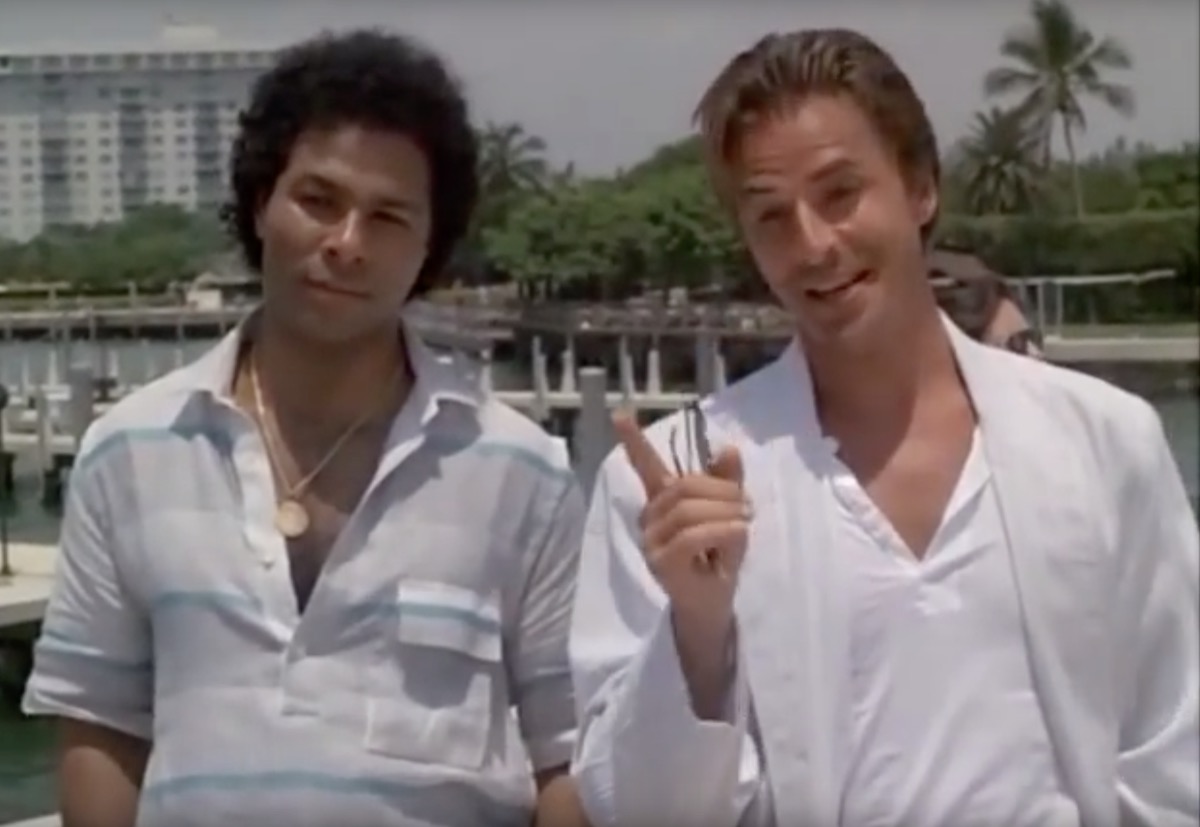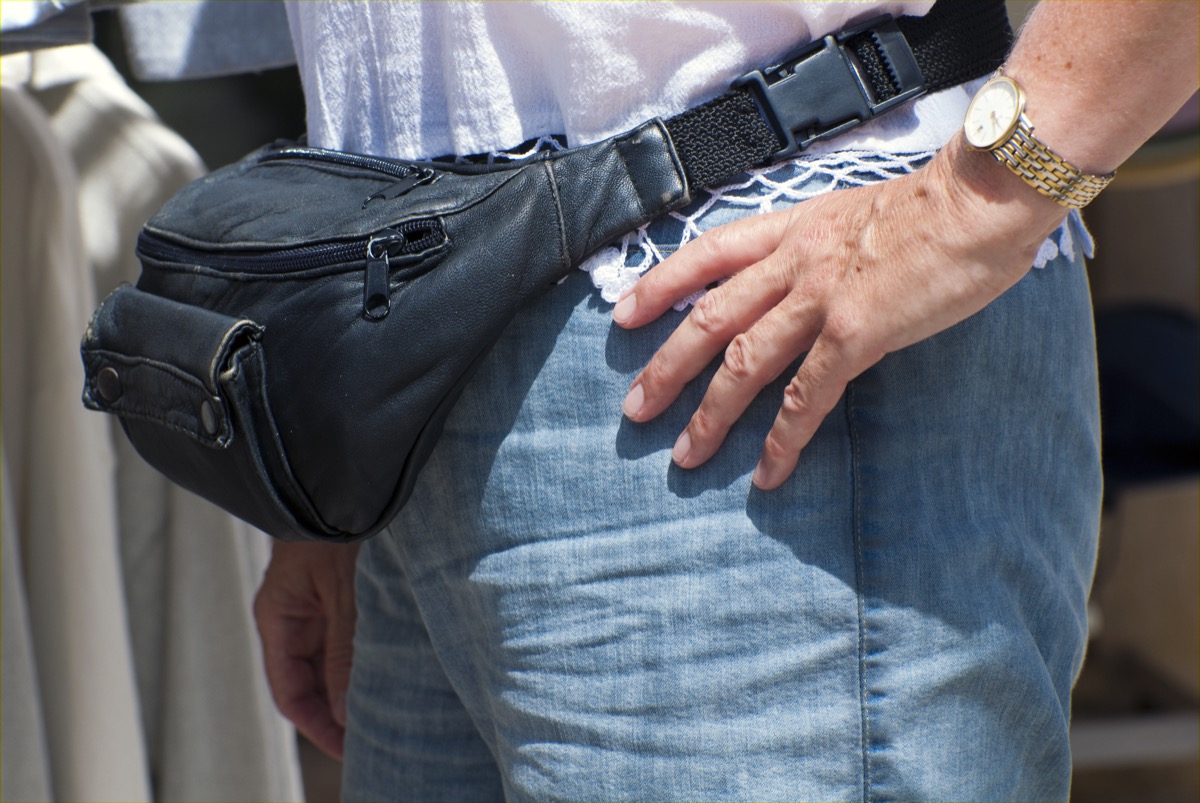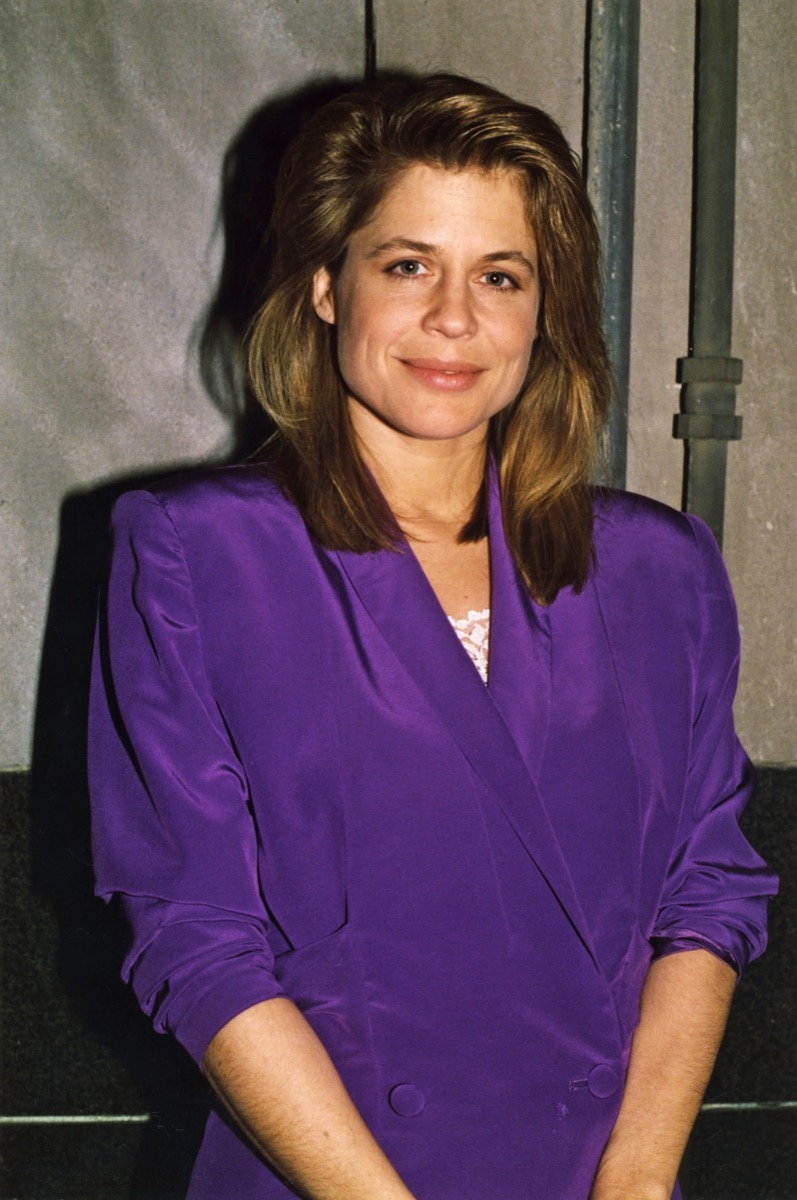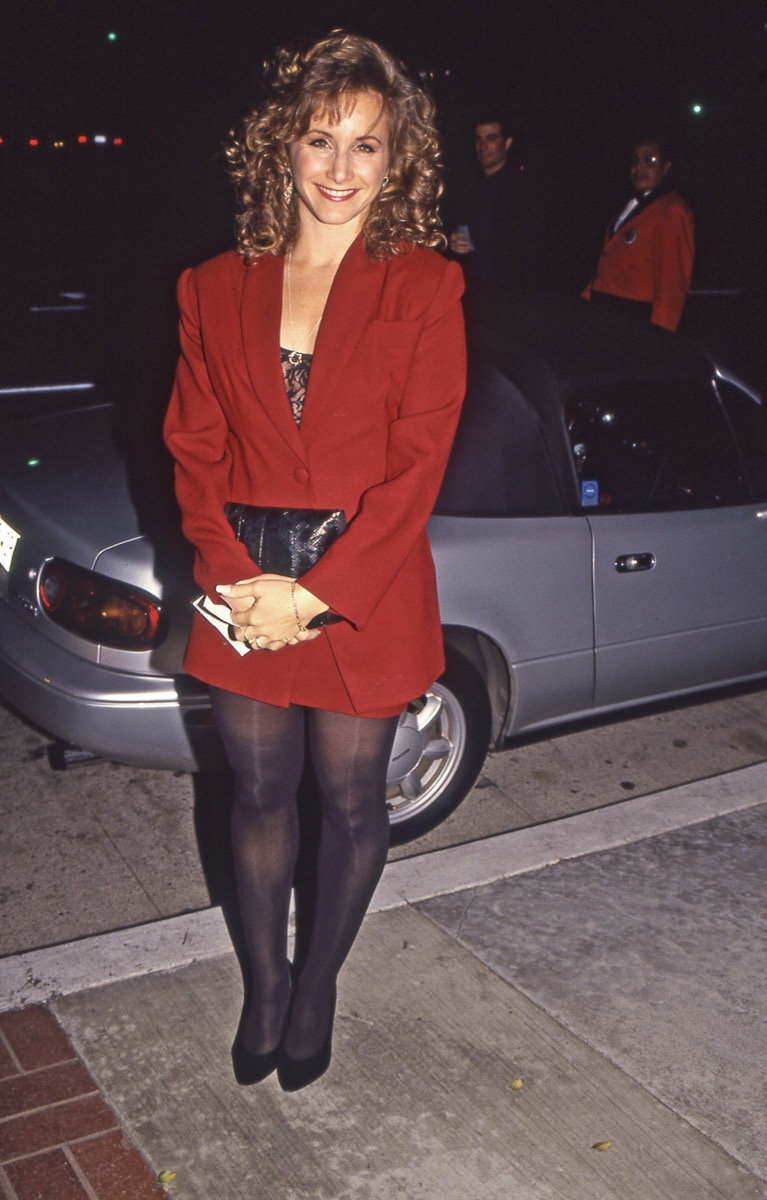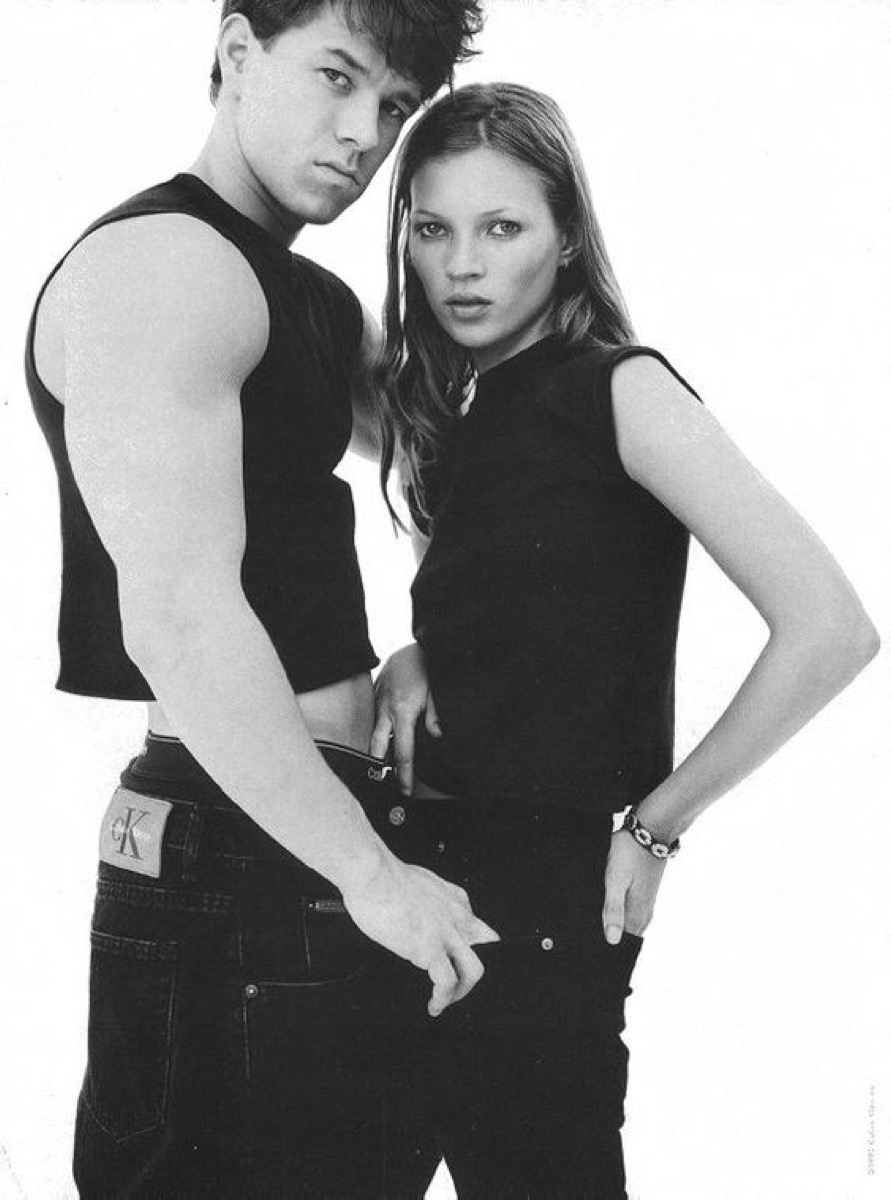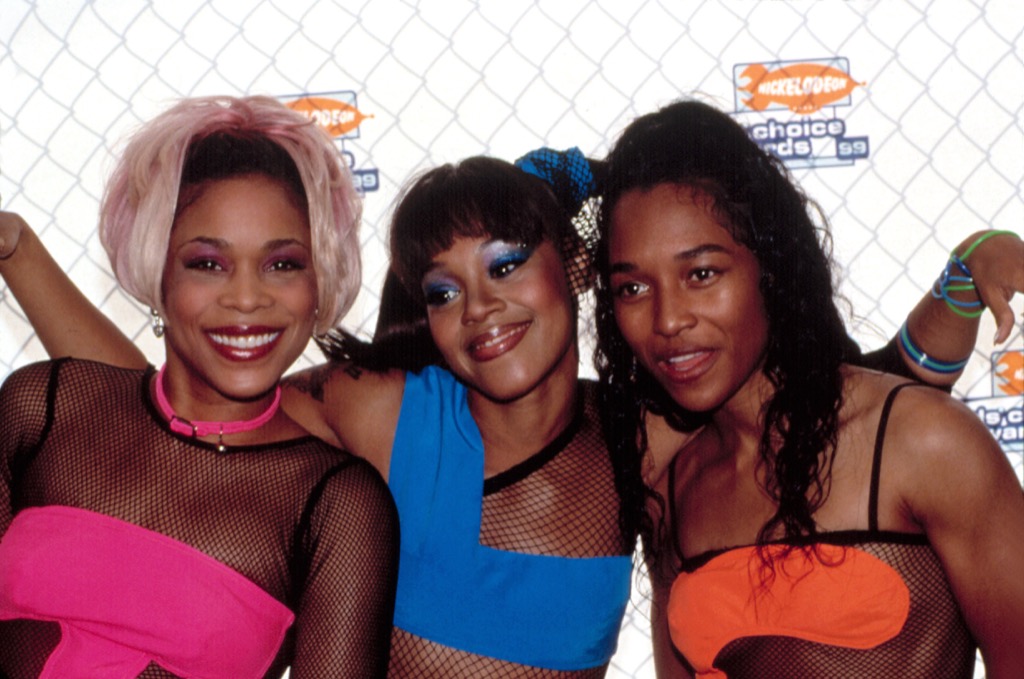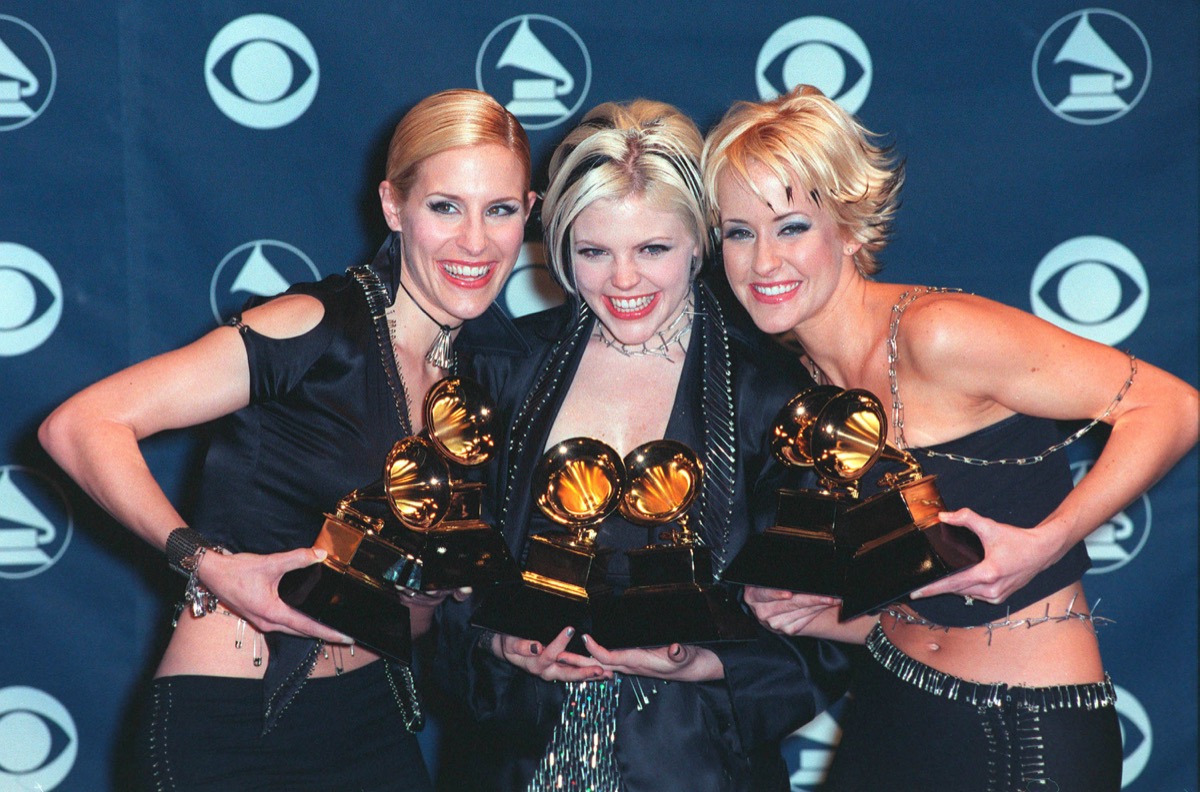Take a trip down memory lane as we recall the worst fashion trend from the year you were born, starting back in 1940. And for more blast from the past style, This Is the “It” Hairstyle the Year You Were Born.
By 1940, both England and France had entered World War II, which made way for American designers to dominate the wardrobes of the world. Some, including Claire McCardell, helped to fill the void of new designs coming out of Paris; in the early 1940s, she introduced the popover dress. Originally meant as a ready-to-wear utility garment, this wrap dress became a go-fashion staple across the country. What makes it so ridiculous, you ask? Well, every $7 dress was sold with an oven mitt that attached via button, according to an exhibit at the Metropolitan Museum of Art. And for more fun retro style, check out these Fashion Trends Only Cool ’90s Kids Will Remember.
In the early 1940s, bowler hats—which were already wildly popular with men—were downsized for feminine sensibilities. The result? Miniaturized bowler hats that women would wear askew. It’s a trend that Vogue noted, in 1941, was “definitely not for the unselfconfident.” Basically, it was a more polite way of saying few could pull this off and thank goodness more didn’t try. In their look back at embarrassing style trends over the years, Harper’s Bazaar deemed it one of the worst of the 1940s, adding, “Miniature hats flatter very few heads.”
World War II had a huge impact on fashion, largely because of fabric rationing. For the most part, garments were designed with that in mind. But safety played a major role, too. Enter: the siren suit, a single-piece garment that was designed to be worn over clothing or pajamas, so you could just throw it on and run to the nearest air raid shelter. Suits were designed for both men and women, and Winston Churchill (pictured here) was one of the style’s biggest fans. The practicality is, of course, understandable. The fact that it was marketed as haute couture? Less so. And for more fashion news delivered to your inbox, sign up for our daily newsletter.
The zoot suit was a baggy, oversized ensemble that made any man who wore one look like he was draped in, well, drapes. (Traditionally, zoot suits were made by buying a suit that was several sizes too large and then tailoring it to fit.) And the zoot suit was not without controversy. As reported by Smithsonian magazine, in June 1943, white U.S. armed forces personnel spent a week assaulting “unpatriotic” men in Los Angeles who championed this trend. The ostensible reason for this spate of violence was to punish those who went against wartime rationing, but the majority of the victims were Mexican-American men. The riots didn’t dampen the style’s popularity, however; it rose through the rest of the decade, before fading into obscurity in the 1950s.
Wearing makeup on your legs in lieu of stockings dates back to the 1920s, but, according to the National Museum of American History, the style hack really took off during World War II, when nylon—the material used to make pantyhose—was rationed. Women would paint their legs with makeup to make it look like they were wearing stockings. (Some creative-minded ladies even went so far as to draw on black lines with eyebrow pencils to simulate seams.) And if you want to avoid a fashion faux pas, discover these 40 Fashion Trends That Aren’t Worth Wearing.
In the 1940s, there was no better way to keep your hair out of your face than with the hair snood. These were typically crocheted (like a fancy hairnet), but a headscarf could also be tied like a snood, as the working woman pictured here proves. For wives working in factories while their husbands were at war, this was the look. (Thank goodness for the invention of ponytail holders.)
You’ve seen them on everyone from Elvis to Brad Pitt over the years, but Hawaiian-style floral print shirts—also called Aloha shirts—have roots that date all the way back to the ’20s. However, their true ascendancy took place in the late 1940s and carried into the 1950s (as you can see from this example on Montgomery Clift in the 1940s-set film From Here to Eternity). According to Racked, members of the U.S. military stationed in Hawaii before, during, and after World War II brought these shirts back as a “badge of honor,” and they quickly became a casual wardrobe staple. And today, they still seem to be the vacation uniform for men of a certain age, no matter what state they’re visiting. As the story goes, in the summer of 1947, science fiction writer and cartoonist Ray Faraday Nelson drafted up a propeller hat as a joke for one of his space-dwelling characters. Soon after the cartoon and his helicopter hat were presented at a sci-fi convention, others took the design and ran with it. Various entities, including legendary toy company Mattel, sold versions of it (like hotcakes) around the country in the late 1940s. Nelson never secured a patent for his “invention,” and, as a result, didn’t see a penny from the sales of this very popular and embarrassing trend. And for more major style blunders, check out The 15 Worst Style Trends from the 2010s, According to Stylists and Designers.
Seeing as 1940s fashion was all about utility, you had to work with what you had—and the horse blanket skirt was one of the last prominent examples of that, according to Atomic Narratives and American Youth: Coming of Age with the Atom, 1945-1955 by Michael Scheibach. They were made of plaid wool horse blankets, which were bound with a black braid and fastened with buckles.
By the late ’40s, fabric shortages weren’t an issue like they were earlier in the decade, so decorative clothing was allowed to flourish. One of the best examples of this is the lampshade dress, which, according to the Library of Congress, rose to popularity at the end of the decade. In their November 1948 issue, Harper’s Bazaar described the lampshade dress as “a brand-new silhouette,” perhaps not fully recognizing that such flagrant, over-the-top ostentatiousness would quickly be looked down upon. And if you’re ready to revamp your wardrobe, start with these 23 Things You Should Toss from Your Closet Forever.
Once decorative fabric took off, it really took off. One key example is the flying panel: an extraneous piece of material affixed to the front, back, or side of a dress or coat. The new style was first featured in the April 1949 issue of Life, which pinpointed Christian Dior as the leading designer of the trend.
In the early 1950s, if you wanted to jazz up an outfit, all you had to do was add a detachable collar. They came in a variety of styles, and, as shown by this 1951 guide, were even simple enough to make right at home. Think of it as a dickey for women and frankly, we’re glad neither stuck around.
In 1952, the United States hit peak “poodlemania,” according to Jennifer Grayer Moore’s Fashion Fads Through American History. Actual poodles on their own were seen as status symbols, but the connection between the fluffy dogs and Parisian fashion took things to a whole new level. In the 1950s, they were all over the big screen—like the colorful bunch Doris Day trotted out in 1952’s April in Paris. Soon enough, poodle patterns started popping up on sweaters, scarves, handbags, and, of course, skirts. Still, despite the ubiquity, this trend was quickly sidelined into the dustbin of fashion history. We have Cristóbal Balenciaga to thank for this ridiculous article of clothing. In 1953, it was the Spanish designer who introduced the balloon jacket, a garment that The Design Museum notes “appeared to lengthen the legs and set the face on a kind of pedestal.” Yes, if you ever longed to look like you were missing a neck, this was the ’50s trend for you.
For the most part, the 1950s were a fantastic time for hats. Still, not all hats stood the test of time. Case in point: the pail hat. A cousin of the equally silly bucket hat, pail hats were a bit more boxy, and—among women, at least—were frequently adorned with flowers, bows, or other ornaments.
Turns out, strange fashion isn’t specific to daytime looks; over the years, there have been plenty of wacky pajamas, too. One example is the shortie nightgown. As seen in the 1953 spread in Ebony pictured here or this McCall’s pattern from 1955, the cringeworthy look came complete with a bloomer set. Thankfully, in the years since, women have found cozier nighttime digs.
As the decade went on, poodles weren’t just for clothing and accessories; they were also for your very own head. By the mid-1950s, salons were reporting that three out of five women were requesting “The Poodle,” thanks to Lucile Ball and her hit show I Love Lucy, which aired from 1951 to 1957. The look gathered tons of curly hair up top and was sleeker on the sides. And there’s a reason we haven’t seen it again in more than 60 years. In the late 1950s, the line between evening wear and nightwear started to blur. As the Fashion Institute of Technology points out, “these dresses lay in-between daywear and evening gowns, falling at the length of a day dress but embellished like evening wear.” Take this Balenciaga nightie-turned-gown look from 1957, for example. Scandalous!
Compared to the tight hourglass dresses that were popular throughout the 1950s, trapeze dresses—flowing, waistless, triangular things—seemed modern by the end of the decade. The 1958 Dior collection, designed by the one and only Yves Saint Laurent, introduced the shape—and here’s Her Royal Highness Princess Margaret taking the ridiculous look in.
The apron skirt was one of the most emblematic symbols of the late 1950s and early ’60s. Fluffy, vibrantly colored, and designed to be worn by housewives, it’s a vestige of a bygone era. Sure, these garments were feminine and fun, but they weren’t practical for cooking and cleaning, and were a sterling example of women’s clothing that happened to be fashionable but not remotely functional.
Culottes, the pant-skirt hybrid, go in and out of style like the tides. But they were extremely popular in the 1960s—especially as a vacationing garment. As the McCall’s blog notes, they were often marketed as “playsuits” for adults. Cringe!
Sometimes, fashion is meant to be as accessible as possible. And sometimes, it’s meant to be as inaccessible as possible. For an example of the latter, look no further than this 1960s issue of Vogue, which featured an impossible-to-pull-off leather turban. And actress and Princess of Monaco Grace Kelly, sported this strange white turban in 1961 at The White House, proving that even the most glamorous women make fashion mistakes.
The roadmap for 1960s fashion was laid out in no small part by Audrey Hepburn’s era-defining role in Breakfast at Tiffany’s, which came out in 1961. While many of the styles from the movie—glamorously oversized sunglasses, opera-sized cigarette holders—were worth copying, some decidedly were not—like the matching headscarf look. And while there’s nothing wrong with a headscarf on principal, we’re glad we’ve moved on from having it match the wearer’s dress, as seen in this 1962 Butterick pattern.
Bold liquid eyeliner. Ostentatious gold jewelry. Geometric haircuts. You can thank Elizabeth Taylor and the 1963 film Cleopatra for popularizing ancient Egyptian-styled fashion.
It’s hard to blame folks of the 1960s for doing as Sean Connery did in the 1964 hit movie Goldfinger, but this romper he donned on screen didn’t withstand the test of time. Any strapping young lad who emulated the look likely regrets it now.
In the mid-1960s, with the Space Race fully underway, it’s no surprise that fashion reflected the cultural obsession of the time. Designers like Andre Courrèges and Pierre Cardin entered into a couture Space Race of their own. In fact, as W reports, Courrèges showed such an interest in space travel that NASA even invited him to come visit Cape Canaveral in Florida. The runway Space Race gave us such retro-futuristic designs as leather skirts-and-suspenders and 23rd-century-inspired construction hats. Thank goodness these looks were quickly blasted to the moon.
Color blocking is one thing, but the trend in the mid- to late ’60s was combining colors that are diametrically opposed and, under no circumstances, go together. For example, Harper’s Bazaar points out this 1966 editorial that featured models wearing—gulp—orange with pink, and yellow with green. Ick!
We may talk about today’s fast fashion as being disposable, but in the 1960s, some of the clothing actually was—because it was made of paper! Scott Paper Tissue (yes, the toilet paper company) introduced paper shift dresses in 1966—and soon others followed suit, as this deal from the hair coloring experts at Breck proves. According to a 1967 article in Time, the dresses sold for around $1. For $7 you could get a paper kaftan, while $12 would buy a man’s suit. And for $15 you could get the paper wedding dress of your dreams. Hope it doesn’t rain!
Typically, men’s fashions are far more staid and boring than women’s looks. But the ’60s and ’70s were definitely an exception. In terms of ornamentation for guys, there was no accessory more beloved in the late ’60s than the pendant necklace. Exhibit A: The 1968 Newsweek trend piece aptly titled, “Penchant for Pendants.” By the end of the 1960s, at the dawn of the psychedelic era, women started rebelling against the plain-colored pantyhose that dominated for decades. Still, according to fashion business manager Kalyani Kala, at the time, going “bare legged … was still too immodest.” So women found a middle ground: fun and flirty patterned tights, as shown on this model.
Jumpsuits knew no gender in the 1970s and were en vogue throughout the decade. According to a trend report in The New York Times from the time, they often had the “silhouette of a garage mechanic, a carpenter, an army nurse, a house painter, [or] a pilot,” as this ad from The Fifth Season at the time proves. Yes, this is “one easy piece” we wish we could easily unsee.
Who wears short shorts? The women of the 1970s, for sure. According to Smithsonian magazine, the style also inspired several hit songs of the time, including James Brown’s “Hot Pants (She Got to Use What She Got to Get What She Wants),” Bobby Byrd’s “Hot Pants/I’m Coming, I’m Coming,” and the Dramatics’ “Hot Pants in the Summertime.” They make even more of an embarrassing statement with these gladiator sandals and stockings.
The ’70s-era Swedish glam group ABBA was no stranger to glitzy costumes, but their flared flashy bell bottoms were particularly memorable. Sure, flares and bell bottoms seem to come and go, but the ’70s iterations were louder than the rest. “In the 1960s and 1970s crochet took off as a freeform means of expression,” notes the Crochet Guild of America. And while we understand crocheted rugs and tapestries—these home accents, after all, remain popular today—we still can’t wrap our heads around the idea of crocheted clothing. There’s really just nothing about crochet—between its lack of coverage and typical heaviness—that makes it appealing as apparel. These Coats and Clark models are real troopers.
In the mid- to late 1970s, the infamous men’s leisure suit was everywhere, which The New York Times referred to as “the most talked‐about, written‐about, sketched, photographed and analyzed category of men’s clothing.” If you’re unfamiliar with this fashion gem, it was often a three-piece ensemble with big safari-like pockets and even bigger lapels. And boy, are we big-time thrilled it’s no longer in style.
In the ’70s, the only way to get customized T-shirts was to make them yourself. As Grayer Moore writes in her book, iron-on letters were placed on everything from hats to jackets to tote bags, making whatever statement ’70s kids were feeling at the time. The letters never looked quite right, even after the hours spent trying to spell out your graduation year or your breakdancing alter ego name. They didn’t even work on Danny Zuko (John Travolta) in Grease!
The most shocking look of 1976 was easily designer Rudi Gernreich’s duotard, which is essentially a unitard, except with three legs. Oh, and it was also meant to be worn by two people: each person got their own leg, and then shared the middle one. It was made for the Bella Lewitzky Dance Company for a performance called Inscape, but it quickly became the talk of the fashion world. Because, well, look at it! In the summer of 2019, the Skirball Culture Center in Los Angeles hosted “Fearless Fashion,” an exhibition of Gernreich’s work, which also includes the controversial monokini. For a fleeting moment, the duotard could be seen in all of its glory.
If you lived through the ’70s, chances are high your mom put a bowl over your head and used scissors to cut around the edges. It was the haircut that won Olympic figure skater Dorothy Hamill the gold in 1976, and caused a very embarrassing hair trend as a result.
According to Business Insider, these pirate-inspired crimes against fashion were all the rage in the late ’70s and early ’80s. “Huge, floppy bow ties, colorful patterned jackets, shirts with ruffles and lace, and trousers that looked more like bell bottoms became much more prevalent,” the website notes. “The typical tuxedo in the ’70s usually had at least two of these elements, if not all of them.” We look back and laugh, but shoulder pads were once championed as the big thing. According to a 1979 Washington Post trend piece, “Shoulder pads—believe it or not—will make you seem taller, your waist appear slimmer, and will anchor your clothes.” It’s no wonder we all bought into this very embarrassing trend, including Prince in the massive ’80s movie Purple Rain.
Movies frequently inspire fashion, and Fame—the 1980 film about high-strung competition at a New York City performing arts high school—did exactly that, ushering in the workout clothing craze of the decade. Legwarmers were the heart of the look, and the heart hasn’t yearned to bring back this accessory in the 40 years since.
There has long been something somewhat glamorous about equestrian fashion. But these incredibly wide-hipped jodhpurs that made their way to the runway in the 1980s took it to a new level. In 1985, one reporter wrote an article for Cincinnati Magazine titled “Cruel Pants: The Unkindest Cut of All” about these riding pants gone wrong.
In 1981, Olivia Newton-John’s smash hit “Physical” cemented the trend that Fame started: casual workout wear. (Today, you’ll recognize it by its more fitting name, “athleisure.”) In the music video for the song, Newton-John rocks a headband. By the next year, the sporty accessory became insanely popular—both in and out of the gym. Thankfully, athleisure has evolved.
In 1981, a former bank president named Preston Haag Sr. went looking for a new business venture. He traveled to Brazil, where he noticed all the young women wearing bright plastic shoes and decided to strike a deal with the local manufacturer to bring them to the States, according to the Ocala Star-Banner. Haag introduced the footwear at the 1982 World’s Fair, but it wasn’t until 1983, after Bloomingdale’s ordered 2,400 pairs of jellies, that the trend took off. Soon enough, everyone learned how painful and sweaty the style was. If you grew up in the ’80s or early ’90s, chances are you had at least one slap bracelet. This bizarre accessory, described by The New York Times as “basically a Venetian blind with an attitude,” was accidentally invented in 1983 by a high school shop teacher from Wisconsin. He showed his creation to an agent who represented toy inventors, and it wasn’t long before children everywhere were slapping their wrists with bendable plastic—that is, before they were banned by teachers across the country.
Soon after Miami Vice made its debut, pastel suits for men started hitting the runways in the mid-’80s—and the sidewalks, too. According to Esquire, the wildly popular show, which ran from 1984 to 1990, singlehandedly prompted men to wear double-breasted suits, loafers, and dramatic V-necks in a variety of soft, pastel colors in an attempt to emulate Sonny Crockett (Don Johnson). Only in the ’80s, folks.
Acid-wash denim was no doubt popular throughout the entirety of the 1980s, but it was everywhere in the middle of the decade. Nowadays, we’re a bit wiser, and realize that, yes, light jeans can look good, but jeans faded to the point of corrosion, less so.
Usually made from nylon, this 1980s accessory was “durable, colorful, practical—and not chic,” Vice bluntly points out. “Their functionality meant they were quickly adopted by tourists, on whom the fanny pack was often a feature of a sloppily-assembled or ill-fitting outfit of T-shirt and baggy shorts. Tourism in both New York and Japan boomed during the ’80s, perhaps solidifying a worldwide image of the sloggy American cramming their belongings in a cheap little bag that rested gently on the butt.” That may be harsh, but it’s also not wrong.
Those who grew up in the 1980s understand just how well Stranger Things, Netflix’s popular ’80s-set sci-fi horror show, nails the decade’s style—like the Members Only jacket championed by Steve “the Hair” Harrington (Joe Keery). It’s the type of garment that instantly sends viewers back to the era. According to Mental Floss, in 1987, Members Only’s sales jumped 15 percent and some stores reported increases of up to 82 percent. But it wasn’t long before guys of the ’80s wondered why they were shelling out $55 for this not-so-special jacket.
Bright, bold, double-breasted power suits were a must-wear for women in the late ’80s, as seen here on Linda Hamilton, star of 1984’s The Terminator. As Vogue summed it up: “Defined by its larger-than-life proportions, such as its trademark linebacker-reminiscent shoulder pads, there were plenty of bossy and brash connotations that came with the corporate costume of the go-big-or-go-home decade.”
At the time, it was seriously sexy. But, in retrospect, it seems downright silly. After all, why wear a suit if you’re only going to wear half of it…and nothing else? Well, that’s exactly what women did who wanted to push the boundaries of the power suit in the late ’80s and early ’90s. They rocked double-breasted blazers so oversized, they looked like dresses. According to Harper’s Bazaar, they usually were only paired with two other accessories: natural makeup and simple gold hoops, a la Beverly Hills, 90210 star Gabrielle Carteris (pictured here).
The turn of the decade was not just hammer time, but hammer pants time. Thanks to MC Hammer and his iconic video for the song “U Can’t Touch This,” America caught its first glimpse of these incredibly baggy trousers that have been mocked ever since.
Whether or not you worked on a farm, you probably wore overalls in the ’90s—sometimes with one (or both) of the straps unbuttoned and hanging down. Will Smith, pictured here, was one of the forefathers of this trend, which he consistently sported on The Fresh Prince of Bel Air from 1990 to 1996.
Light up sneakers made their debut back in 1992, courtesy of sneaker manufacturer L.A. Gear. Their iconic L.A. Lights, which lit up with every step, made ’90s kids feel like they were walking right into the future. Ironically, now they just look supremely dated.
Today, you don’t see a lot of men wearing crop tops. But once upon a time, guys from Will Smith to Mark Wahlberg (pictured here in a 1992 Calvin Klein ad with Kate Moss), commonly rocked the look. As Vicki Karaminas, a professor from the School of Design at Massey University in New Zealand, explained to Vice, men’s crop tops originated in the hyper-masculine environment of football (the global version, not the American one). “The midriff cut extended their silhouette and enhanced the size of their torso and muscles,” she said. “It was a very masculine gesture, or look.” ae0fcc31ae342fd3a1346ebb1f342fcb Flannel shirts. Dr. Martens. Roughed up cardigans. Yes, by 1994, fashion was absolutely dominated by the grunge style popularized by rockers like Nirvana frontman Kurt Cobain (pictured here). But, according to Harper’s Bazaar, it was a collection by Marc Jacobs—released in 1993—that really cemented the look that we’d simply write-off as sloppy today.
Baggy jeans reigned supreme in the 1990s, and they stayed that way until Cher Horowitz (Alicia Silverstone) finally put them in their place in 1995’s Clueless (pictured here). She forever rendered them uncool when she said, “Okay, I don’t want to be a traitor to my generation and all but I don’t get how guys dress today. I mean, come on, it looks like they just fell out of bed and put on some baggy pants … and we’re supposed to swoon? I don’t think so!” Yeah: As if!
Yes, supermodels like Kendall Jenner and Bella Hadid currently swear by the tiny sunglasses trend. But it’s a resurgence, and a widely lambasted one, at that. As Ellen DeGeneres and her then-girlfriend Anne Heche prove here, in the mid-1990s, these tiny sunglasses were no snazzier, coming in horrific tints like blue, pink, and yellow. No, thanks!
Athleisure had another major moment in the mid-’90s. Everyone from Missy Elliot to Aaliyah to Mel C of the Spice Girls (pictured here) wore Adidas’s signature tri-striped track suits. “By the ’90s, the tracksuit itself was entrenched both as an on-field athletic staple, as well as a hip-hop icon,” notes Complex. “While earlier decades focused on a slimmer fit, these renditions were cut with a relaxed silhouette, making them perfect for pre and post-game attire, but also perfect for lounging around.” We can’t hate on the comfort, but we’ve luckily evolved since then.
In the late 1990s, it wasn’t enough to put your hair up in a ponytail or bun: You needed some sort of plastic clip to seal the deal. According to Bust, one option was the ubiquitous claw clip, which allowed you to twist your locks up and secure it at the nape of your neck. The other—butterfly clips—were smaller and more ornamental than functional, holding back tiny twists that lead to your updo du jour. It was, as Tim Gunn would say, a lot of look.
If you owned one type of necklace in the late ’90s, it would have been a choker (like T-Boz’s pictured here on the left). Whether it was plain black, made of stretchy material to look like a tattoo, or a ribbon with a cameo hanging off the middle, chokers were the accessory at the end of the decade, according to Cosmopolitan.
In the year 2000—and, sadly, for the few years that followed—ultra-low-rise jeans were everywhere, including on Grammy winners the Dixie Chicks, pictured here. Paired with safety pin belts and shirts that barely grazed belly buttons, when it came to denim, the lower the better. And now, according to Glamour, they’re on the brink of returning. Will we ever learn?! If you want to see why we certainly won’t, be sure to check out these 20 Modern Style Trends Guaranteed to Make Us Cringe in 20 Years.
